Developing and Implementing Strategy | Qantas Airways
VerifiedAdded on 2022/08/12
|21
|4791
|11
AI Summary
Contribute Materials
Your contribution can guide someone’s learning journey. Share your
documents today.
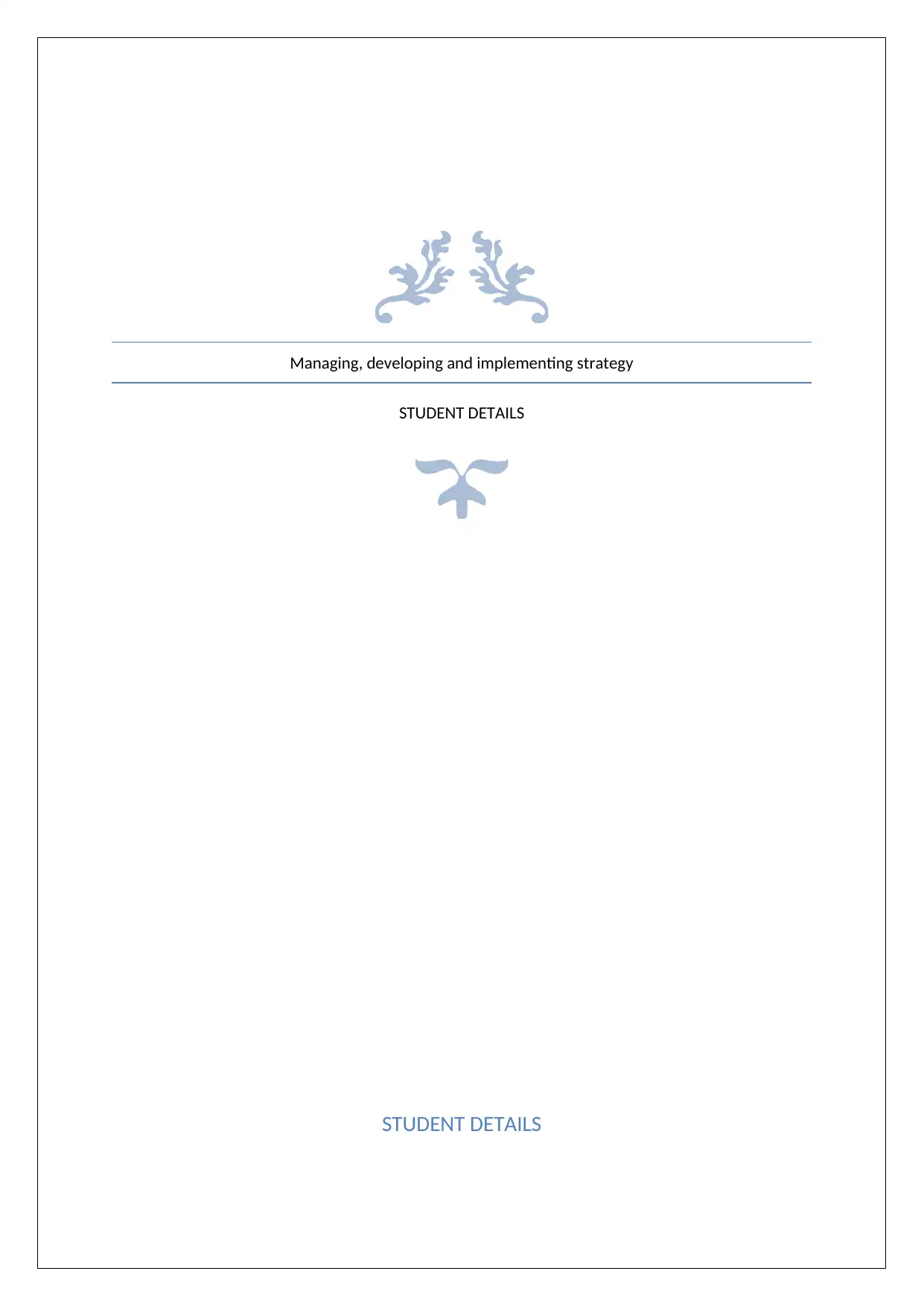
Managing, developing and implementing strategy
STUDENT DETAILS
STUDENT DETAILS
STUDENT DETAILS
STUDENT DETAILS
Secure Best Marks with AI Grader
Need help grading? Try our AI Grader for instant feedback on your assignments.
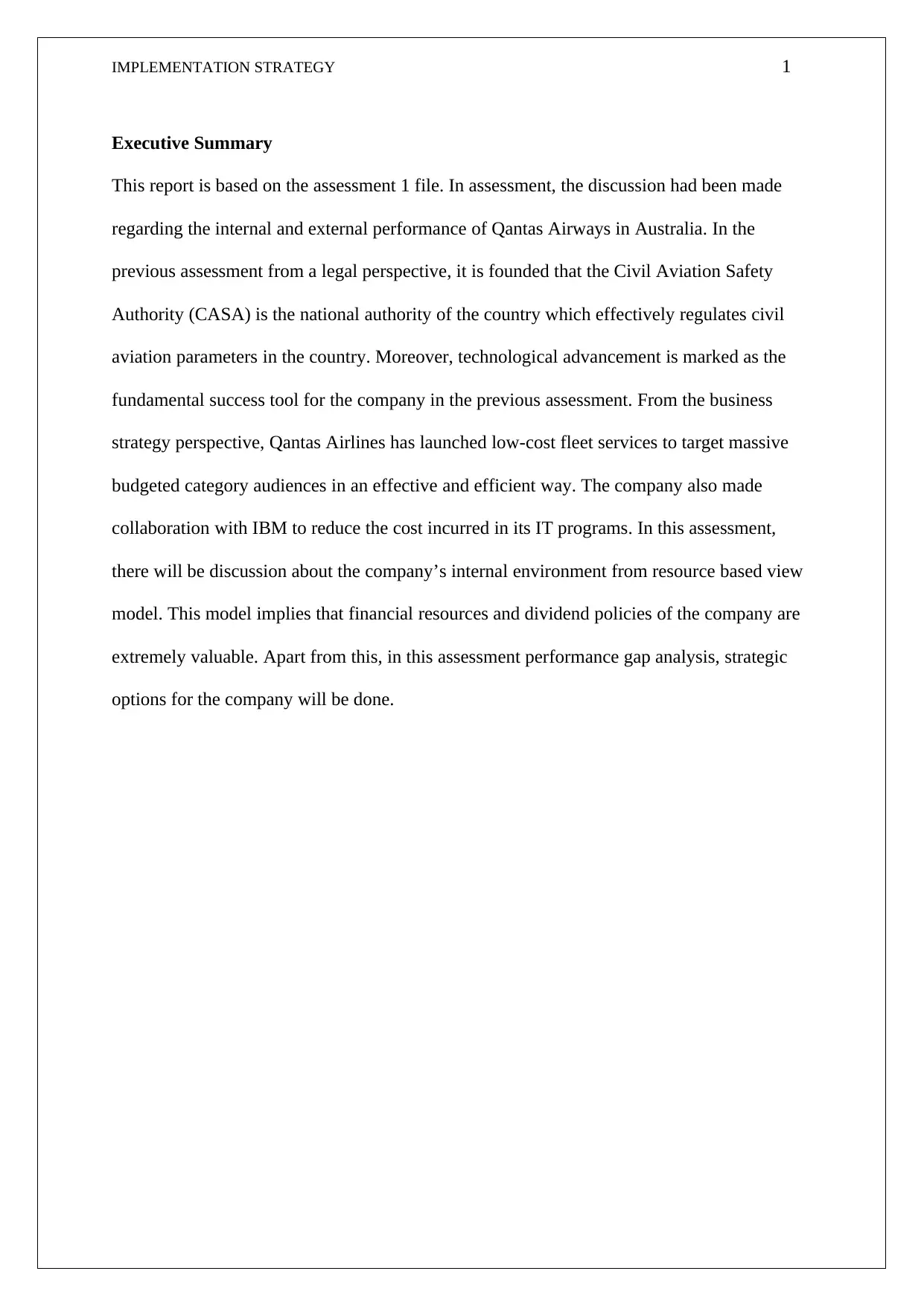
IMPLEMENTATION STRATEGY 1
Executive Summary
This report is based on the assessment 1 file. In assessment, the discussion had been made
regarding the internal and external performance of Qantas Airways in Australia. In the
previous assessment from a legal perspective, it is founded that the Civil Aviation Safety
Authority (CASA) is the national authority of the country which effectively regulates civil
aviation parameters in the country. Moreover, technological advancement is marked as the
fundamental success tool for the company in the previous assessment. From the business
strategy perspective, Qantas Airlines has launched low-cost fleet services to target massive
budgeted category audiences in an effective and efficient way. The company also made
collaboration with IBM to reduce the cost incurred in its IT programs. In this assessment,
there will be discussion about the company’s internal environment from resource based view
model. This model implies that financial resources and dividend policies of the company are
extremely valuable. Apart from this, in this assessment performance gap analysis, strategic
options for the company will be done.
Executive Summary
This report is based on the assessment 1 file. In assessment, the discussion had been made
regarding the internal and external performance of Qantas Airways in Australia. In the
previous assessment from a legal perspective, it is founded that the Civil Aviation Safety
Authority (CASA) is the national authority of the country which effectively regulates civil
aviation parameters in the country. Moreover, technological advancement is marked as the
fundamental success tool for the company in the previous assessment. From the business
strategy perspective, Qantas Airlines has launched low-cost fleet services to target massive
budgeted category audiences in an effective and efficient way. The company also made
collaboration with IBM to reduce the cost incurred in its IT programs. In this assessment,
there will be discussion about the company’s internal environment from resource based view
model. This model implies that financial resources and dividend policies of the company are
extremely valuable. Apart from this, in this assessment performance gap analysis, strategic
options for the company will be done.
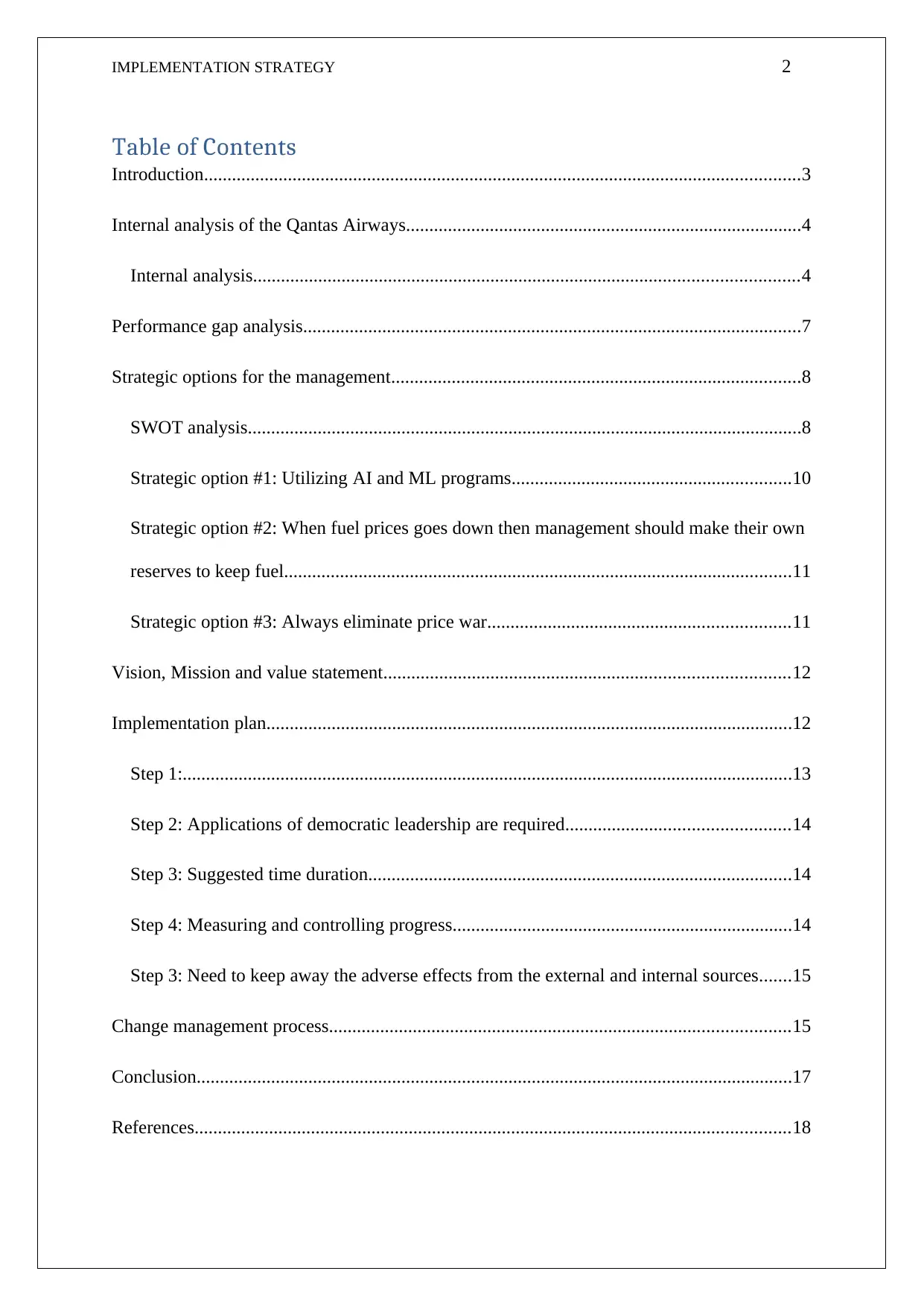
IMPLEMENTATION STRATEGY 2
Table of Contents
Introduction................................................................................................................................3
Internal analysis of the Qantas Airways.....................................................................................4
Internal analysis.....................................................................................................................4
Performance gap analysis...........................................................................................................7
Strategic options for the management........................................................................................8
SWOT analysis.......................................................................................................................8
Strategic option #1: Utilizing AI and ML programs............................................................10
Strategic option #2: When fuel prices goes down then management should make their own
reserves to keep fuel.............................................................................................................11
Strategic option #3: Always eliminate price war.................................................................11
Vision, Mission and value statement.......................................................................................12
Implementation plan.................................................................................................................12
Step 1:...................................................................................................................................13
Step 2: Applications of democratic leadership are required................................................14
Step 3: Suggested time duration...........................................................................................14
Step 4: Measuring and controlling progress.........................................................................14
Step 3: Need to keep away the adverse effects from the external and internal sources.......15
Change management process...................................................................................................15
Conclusion................................................................................................................................17
References................................................................................................................................18
Table of Contents
Introduction................................................................................................................................3
Internal analysis of the Qantas Airways.....................................................................................4
Internal analysis.....................................................................................................................4
Performance gap analysis...........................................................................................................7
Strategic options for the management........................................................................................8
SWOT analysis.......................................................................................................................8
Strategic option #1: Utilizing AI and ML programs............................................................10
Strategic option #2: When fuel prices goes down then management should make their own
reserves to keep fuel.............................................................................................................11
Strategic option #3: Always eliminate price war.................................................................11
Vision, Mission and value statement.......................................................................................12
Implementation plan.................................................................................................................12
Step 1:...................................................................................................................................13
Step 2: Applications of democratic leadership are required................................................14
Step 3: Suggested time duration...........................................................................................14
Step 4: Measuring and controlling progress.........................................................................14
Step 3: Need to keep away the adverse effects from the external and internal sources.......15
Change management process...................................................................................................15
Conclusion................................................................................................................................17
References................................................................................................................................18
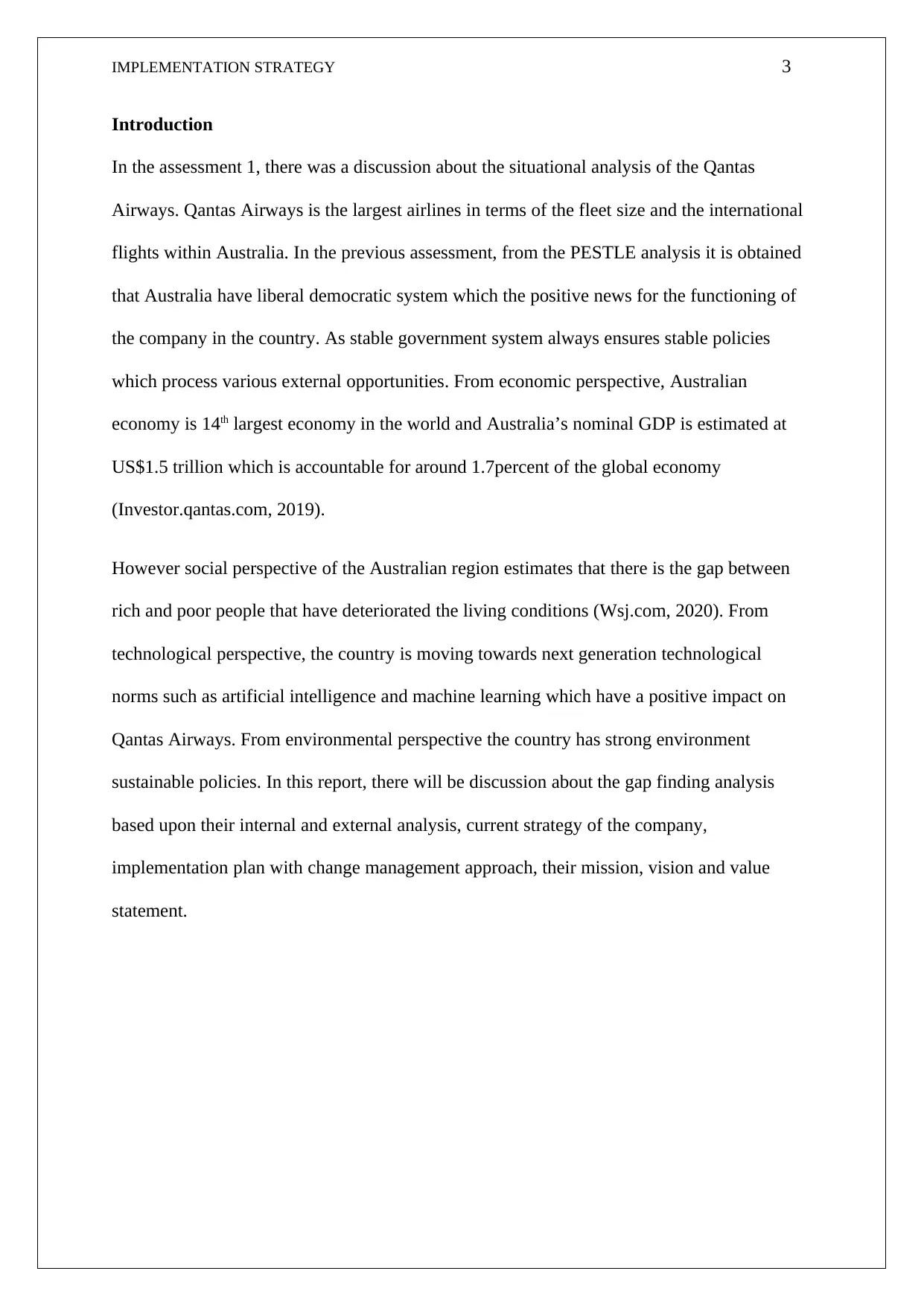
IMPLEMENTATION STRATEGY 3
Introduction
In the assessment 1, there was a discussion about the situational analysis of the Qantas
Airways. Qantas Airways is the largest airlines in terms of the fleet size and the international
flights within Australia. In the previous assessment, from the PESTLE analysis it is obtained
that Australia have liberal democratic system which the positive news for the functioning of
the company in the country. As stable government system always ensures stable policies
which process various external opportunities. From economic perspective, Australian
economy is 14th largest economy in the world and Australia’s nominal GDP is estimated at
US$1.5 trillion which is accountable for around 1.7percent of the global economy
(Investor.qantas.com, 2019).
However social perspective of the Australian region estimates that there is the gap between
rich and poor people that have deteriorated the living conditions (Wsj.com, 2020). From
technological perspective, the country is moving towards next generation technological
norms such as artificial intelligence and machine learning which have a positive impact on
Qantas Airways. From environmental perspective the country has strong environment
sustainable policies. In this report, there will be discussion about the gap finding analysis
based upon their internal and external analysis, current strategy of the company,
implementation plan with change management approach, their mission, vision and value
statement.
Introduction
In the assessment 1, there was a discussion about the situational analysis of the Qantas
Airways. Qantas Airways is the largest airlines in terms of the fleet size and the international
flights within Australia. In the previous assessment, from the PESTLE analysis it is obtained
that Australia have liberal democratic system which the positive news for the functioning of
the company in the country. As stable government system always ensures stable policies
which process various external opportunities. From economic perspective, Australian
economy is 14th largest economy in the world and Australia’s nominal GDP is estimated at
US$1.5 trillion which is accountable for around 1.7percent of the global economy
(Investor.qantas.com, 2019).
However social perspective of the Australian region estimates that there is the gap between
rich and poor people that have deteriorated the living conditions (Wsj.com, 2020). From
technological perspective, the country is moving towards next generation technological
norms such as artificial intelligence and machine learning which have a positive impact on
Qantas Airways. From environmental perspective the country has strong environment
sustainable policies. In this report, there will be discussion about the gap finding analysis
based upon their internal and external analysis, current strategy of the company,
implementation plan with change management approach, their mission, vision and value
statement.
Secure Best Marks with AI Grader
Need help grading? Try our AI Grader for instant feedback on your assignments.
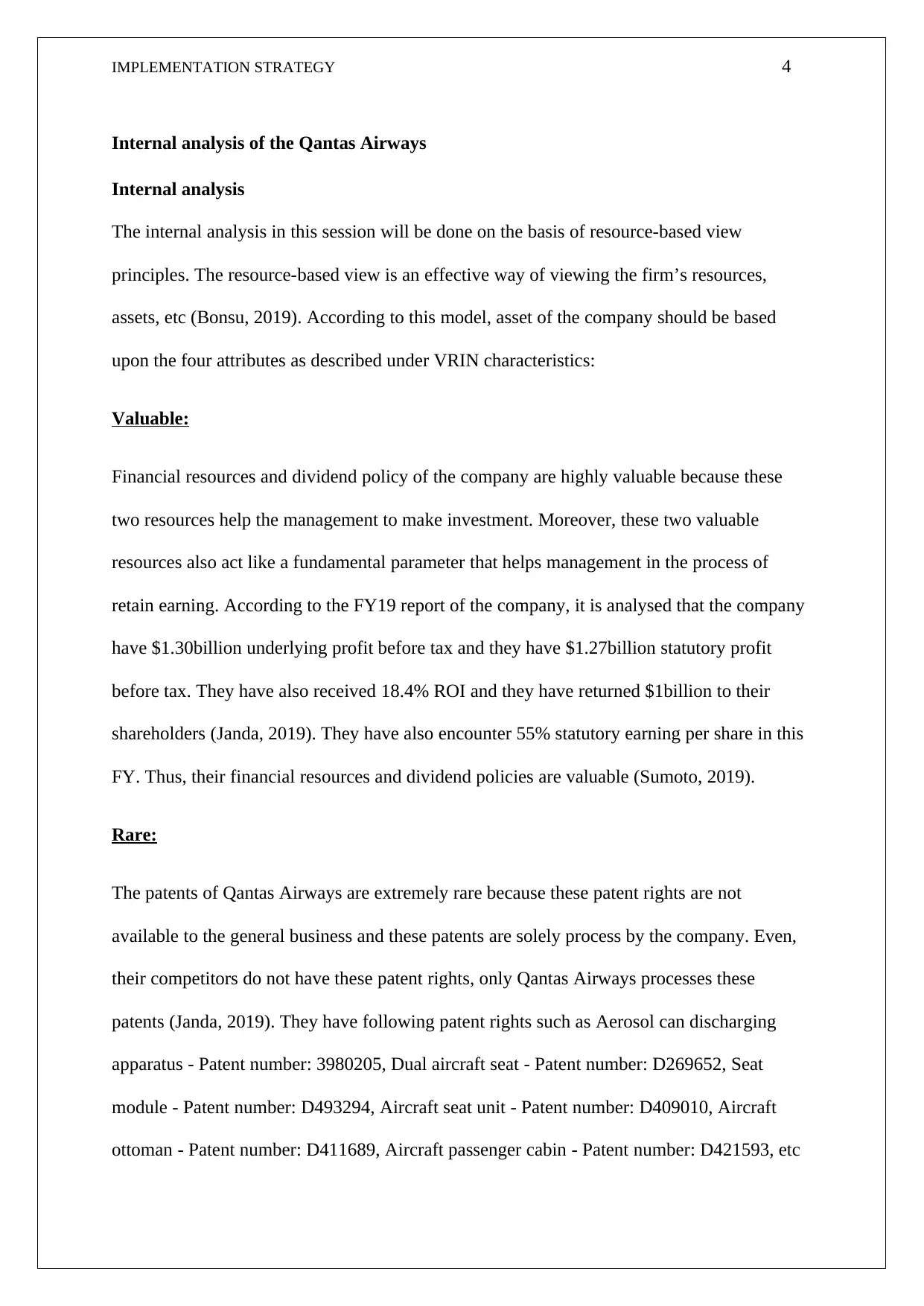
IMPLEMENTATION STRATEGY 4
Internal analysis of the Qantas Airways
Internal analysis
The internal analysis in this session will be done on the basis of resource-based view
principles. The resource-based view is an effective way of viewing the firm’s resources,
assets, etc (Bonsu, 2019). According to this model, asset of the company should be based
upon the four attributes as described under VRIN characteristics:
Valuable:
Financial resources and dividend policy of the company are highly valuable because these
two resources help the management to make investment. Moreover, these two valuable
resources also act like a fundamental parameter that helps management in the process of
retain earning. According to the FY19 report of the company, it is analysed that the company
have $1.30billion underlying profit before tax and they have $1.27billion statutory profit
before tax. They have also received 18.4% ROI and they have returned $1billion to their
shareholders (Janda, 2019). They have also encounter 55% statutory earning per share in this
FY. Thus, their financial resources and dividend policies are valuable (Sumoto, 2019).
Rare:
The patents of Qantas Airways are extremely rare because these patent rights are not
available to the general business and these patents are solely process by the company. Even,
their competitors do not have these patent rights, only Qantas Airways processes these
patents (Janda, 2019). They have following patent rights such as Aerosol can discharging
apparatus - Patent number: 3980205, Dual aircraft seat - Patent number: D269652, Seat
module - Patent number: D493294, Aircraft seat unit - Patent number: D409010, Aircraft
ottoman - Patent number: D411689, Aircraft passenger cabin - Patent number: D421593, etc
Internal analysis of the Qantas Airways
Internal analysis
The internal analysis in this session will be done on the basis of resource-based view
principles. The resource-based view is an effective way of viewing the firm’s resources,
assets, etc (Bonsu, 2019). According to this model, asset of the company should be based
upon the four attributes as described under VRIN characteristics:
Valuable:
Financial resources and dividend policy of the company are highly valuable because these
two resources help the management to make investment. Moreover, these two valuable
resources also act like a fundamental parameter that helps management in the process of
retain earning. According to the FY19 report of the company, it is analysed that the company
have $1.30billion underlying profit before tax and they have $1.27billion statutory profit
before tax. They have also received 18.4% ROI and they have returned $1billion to their
shareholders (Janda, 2019). They have also encounter 55% statutory earning per share in this
FY. Thus, their financial resources and dividend policies are valuable (Sumoto, 2019).
Rare:
The patents of Qantas Airways are extremely rare because these patent rights are not
available to the general business and these patents are solely process by the company. Even,
their competitors do not have these patent rights, only Qantas Airways processes these
patents (Janda, 2019). They have following patent rights such as Aerosol can discharging
apparatus - Patent number: 3980205, Dual aircraft seat - Patent number: D269652, Seat
module - Patent number: D493294, Aircraft seat unit - Patent number: D409010, Aircraft
ottoman - Patent number: D411689, Aircraft passenger cabin - Patent number: D421593, etc
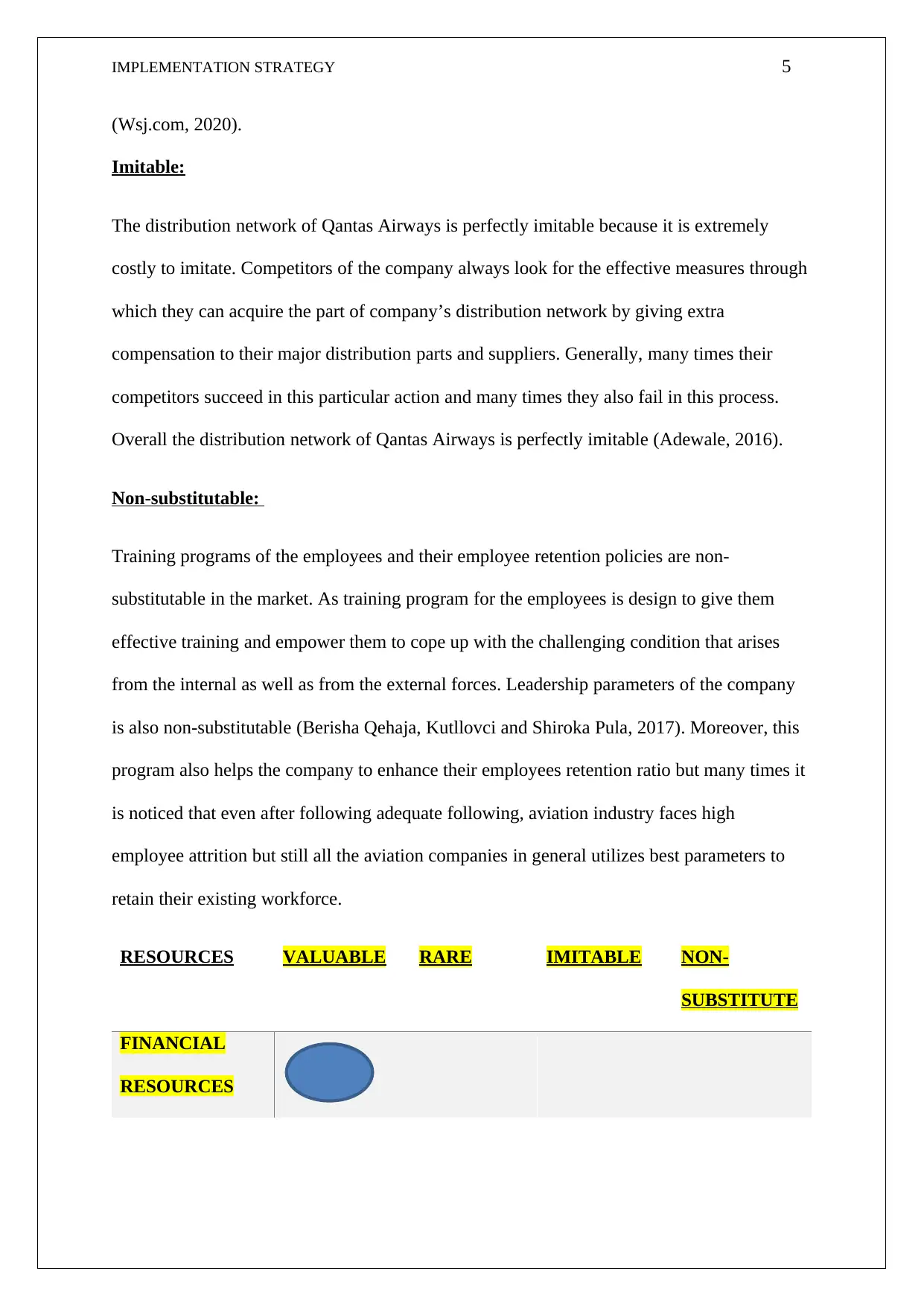
IMPLEMENTATION STRATEGY 5
(Wsj.com, 2020).
Imitable:
The distribution network of Qantas Airways is perfectly imitable because it is extremely
costly to imitate. Competitors of the company always look for the effective measures through
which they can acquire the part of company’s distribution network by giving extra
compensation to their major distribution parts and suppliers. Generally, many times their
competitors succeed in this particular action and many times they also fail in this process.
Overall the distribution network of Qantas Airways is perfectly imitable (Adewale, 2016).
Non-substitutable:
Training programs of the employees and their employee retention policies are non-
substitutable in the market. As training program for the employees is design to give them
effective training and empower them to cope up with the challenging condition that arises
from the internal as well as from the external forces. Leadership parameters of the company
is also non-substitutable (Berisha Qehaja, Kutllovci and Shiroka Pula, 2017). Moreover, this
program also helps the company to enhance their employees retention ratio but many times it
is noticed that even after following adequate following, aviation industry faces high
employee attrition but still all the aviation companies in general utilizes best parameters to
retain their existing workforce.
RESOURCES VALUABLE RARE IMITABLE NON-
SUBSTITUTE
FINANCIAL
RESOURCES
(Wsj.com, 2020).
Imitable:
The distribution network of Qantas Airways is perfectly imitable because it is extremely
costly to imitate. Competitors of the company always look for the effective measures through
which they can acquire the part of company’s distribution network by giving extra
compensation to their major distribution parts and suppliers. Generally, many times their
competitors succeed in this particular action and many times they also fail in this process.
Overall the distribution network of Qantas Airways is perfectly imitable (Adewale, 2016).
Non-substitutable:
Training programs of the employees and their employee retention policies are non-
substitutable in the market. As training program for the employees is design to give them
effective training and empower them to cope up with the challenging condition that arises
from the internal as well as from the external forces. Leadership parameters of the company
is also non-substitutable (Berisha Qehaja, Kutllovci and Shiroka Pula, 2017). Moreover, this
program also helps the company to enhance their employees retention ratio but many times it
is noticed that even after following adequate following, aviation industry faces high
employee attrition but still all the aviation companies in general utilizes best parameters to
retain their existing workforce.
RESOURCES VALUABLE RARE IMITABLE NON-
SUBSTITUTE
FINANCIAL
RESOURCES
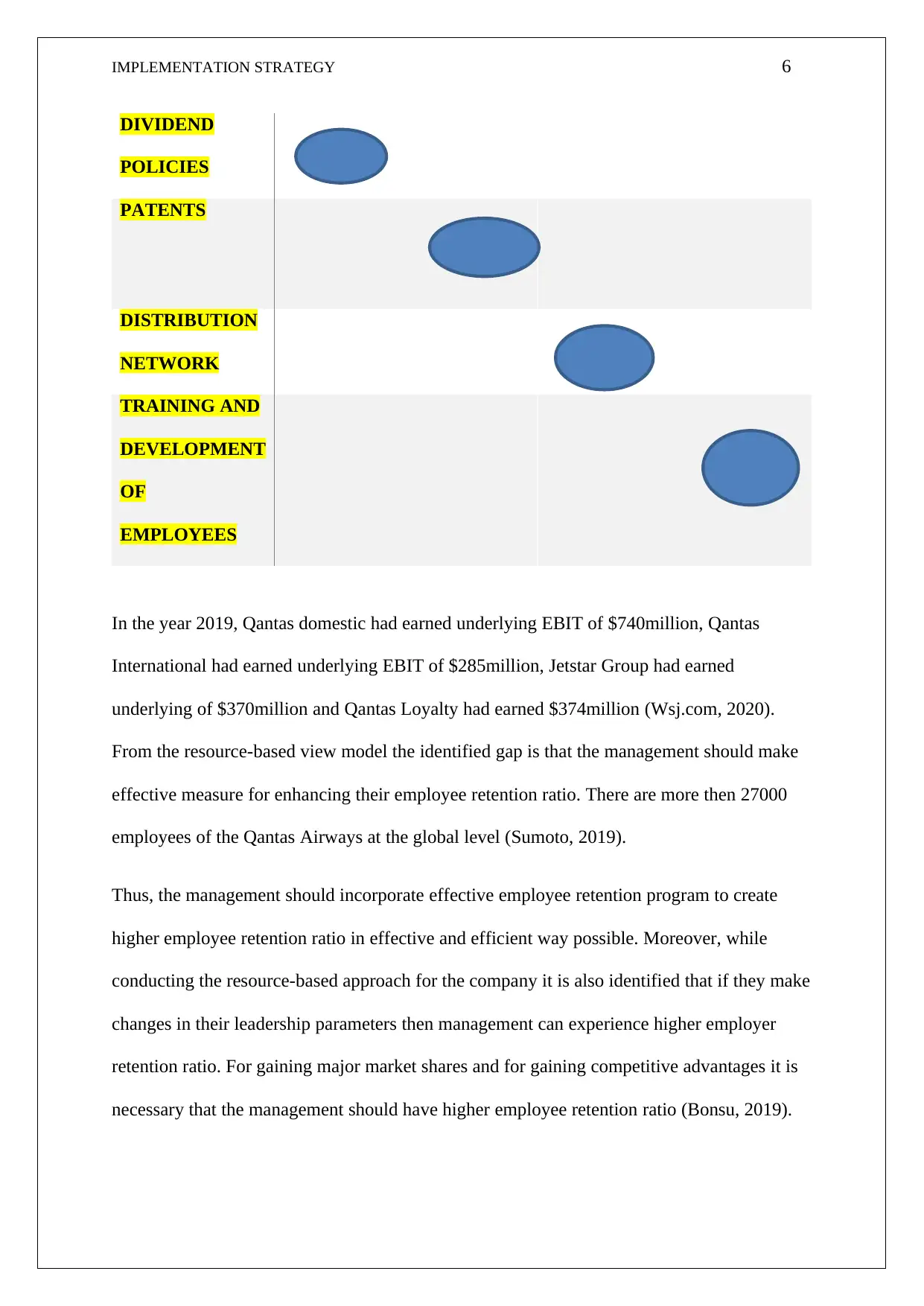
IMPLEMENTATION STRATEGY 6
DIVIDEND
POLICIES
PATENTS
DISTRIBUTION
NETWORK
TRAINING AND
DEVELOPMENT
OF
EMPLOYEES
In the year 2019, Qantas domestic had earned underlying EBIT of $740million, Qantas
International had earned underlying EBIT of $285million, Jetstar Group had earned
underlying of $370million and Qantas Loyalty had earned $374million (Wsj.com, 2020).
From the resource-based view model the identified gap is that the management should make
effective measure for enhancing their employee retention ratio. There are more then 27000
employees of the Qantas Airways at the global level (Sumoto, 2019).
Thus, the management should incorporate effective employee retention program to create
higher employee retention ratio in effective and efficient way possible. Moreover, while
conducting the resource-based approach for the company it is also identified that if they make
changes in their leadership parameters then management can experience higher employer
retention ratio. For gaining major market shares and for gaining competitive advantages it is
necessary that the management should have higher employee retention ratio (Bonsu, 2019).
DIVIDEND
POLICIES
PATENTS
DISTRIBUTION
NETWORK
TRAINING AND
DEVELOPMENT
OF
EMPLOYEES
In the year 2019, Qantas domestic had earned underlying EBIT of $740million, Qantas
International had earned underlying EBIT of $285million, Jetstar Group had earned
underlying of $370million and Qantas Loyalty had earned $374million (Wsj.com, 2020).
From the resource-based view model the identified gap is that the management should make
effective measure for enhancing their employee retention ratio. There are more then 27000
employees of the Qantas Airways at the global level (Sumoto, 2019).
Thus, the management should incorporate effective employee retention program to create
higher employee retention ratio in effective and efficient way possible. Moreover, while
conducting the resource-based approach for the company it is also identified that if they make
changes in their leadership parameters then management can experience higher employer
retention ratio. For gaining major market shares and for gaining competitive advantages it is
necessary that the management should have higher employee retention ratio (Bonsu, 2019).
Paraphrase This Document
Need a fresh take? Get an instant paraphrase of this document with our AI Paraphraser
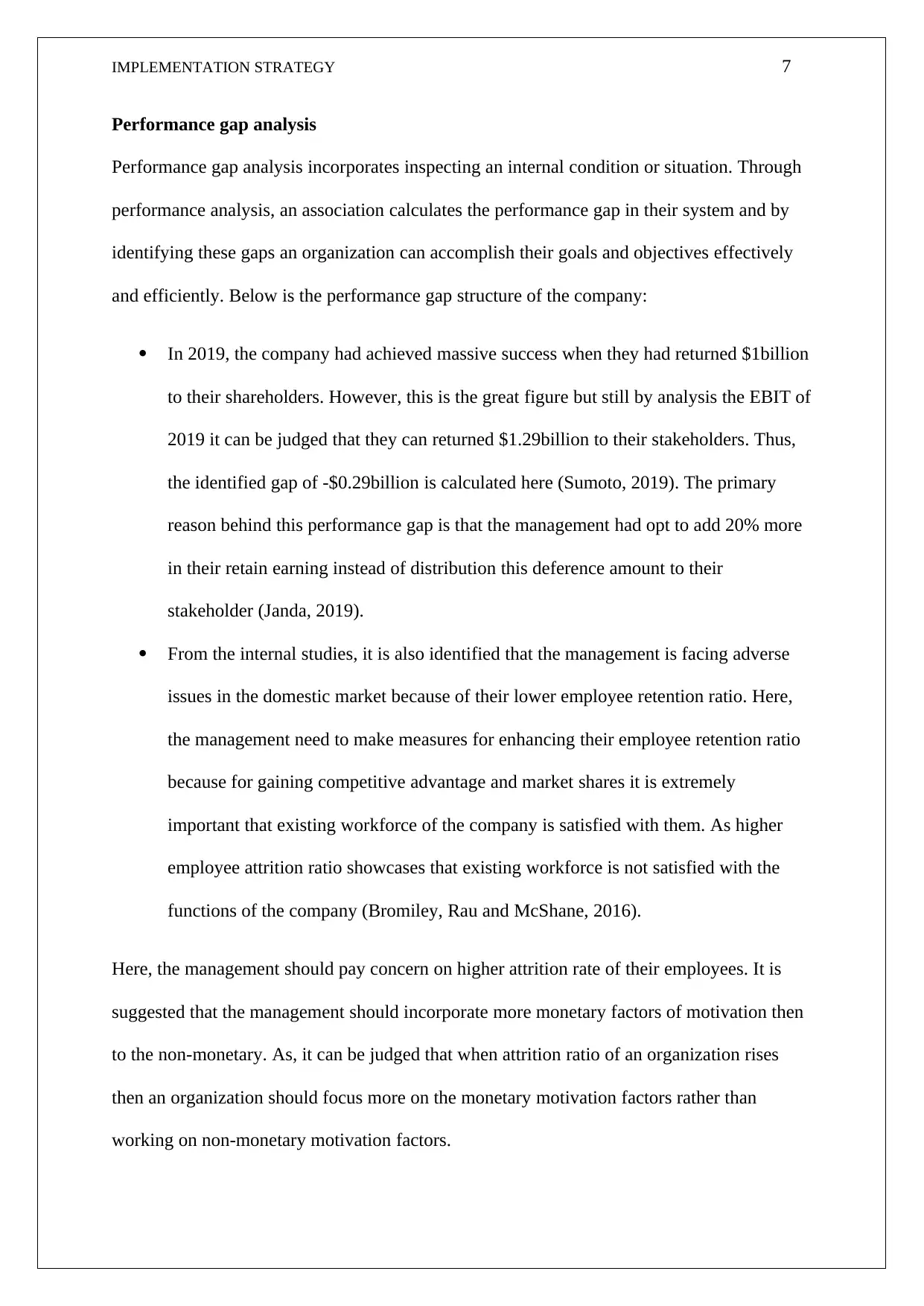
IMPLEMENTATION STRATEGY 7
Performance gap analysis
Performance gap analysis incorporates inspecting an internal condition or situation. Through
performance analysis, an association calculates the performance gap in their system and by
identifying these gaps an organization can accomplish their goals and objectives effectively
and efficiently. Below is the performance gap structure of the company:
In 2019, the company had achieved massive success when they had returned $1billion
to their shareholders. However, this is the great figure but still by analysis the EBIT of
2019 it can be judged that they can returned $1.29billion to their stakeholders. Thus,
the identified gap of -$0.29billion is calculated here (Sumoto, 2019). The primary
reason behind this performance gap is that the management had opt to add 20% more
in their retain earning instead of distribution this deference amount to their
stakeholder (Janda, 2019).
From the internal studies, it is also identified that the management is facing adverse
issues in the domestic market because of their lower employee retention ratio. Here,
the management need to make measures for enhancing their employee retention ratio
because for gaining competitive advantage and market shares it is extremely
important that existing workforce of the company is satisfied with them. As higher
employee attrition ratio showcases that existing workforce is not satisfied with the
functions of the company (Bromiley, Rau and McShane, 2016).
Here, the management should pay concern on higher attrition rate of their employees. It is
suggested that the management should incorporate more monetary factors of motivation then
to the non-monetary. As, it can be judged that when attrition ratio of an organization rises
then an organization should focus more on the monetary motivation factors rather than
working on non-monetary motivation factors.
Performance gap analysis
Performance gap analysis incorporates inspecting an internal condition or situation. Through
performance analysis, an association calculates the performance gap in their system and by
identifying these gaps an organization can accomplish their goals and objectives effectively
and efficiently. Below is the performance gap structure of the company:
In 2019, the company had achieved massive success when they had returned $1billion
to their shareholders. However, this is the great figure but still by analysis the EBIT of
2019 it can be judged that they can returned $1.29billion to their stakeholders. Thus,
the identified gap of -$0.29billion is calculated here (Sumoto, 2019). The primary
reason behind this performance gap is that the management had opt to add 20% more
in their retain earning instead of distribution this deference amount to their
stakeholder (Janda, 2019).
From the internal studies, it is also identified that the management is facing adverse
issues in the domestic market because of their lower employee retention ratio. Here,
the management need to make measures for enhancing their employee retention ratio
because for gaining competitive advantage and market shares it is extremely
important that existing workforce of the company is satisfied with them. As higher
employee attrition ratio showcases that existing workforce is not satisfied with the
functions of the company (Bromiley, Rau and McShane, 2016).
Here, the management should pay concern on higher attrition rate of their employees. It is
suggested that the management should incorporate more monetary factors of motivation then
to the non-monetary. As, it can be judged that when attrition ratio of an organization rises
then an organization should focus more on the monetary motivation factors rather than
working on non-monetary motivation factors.
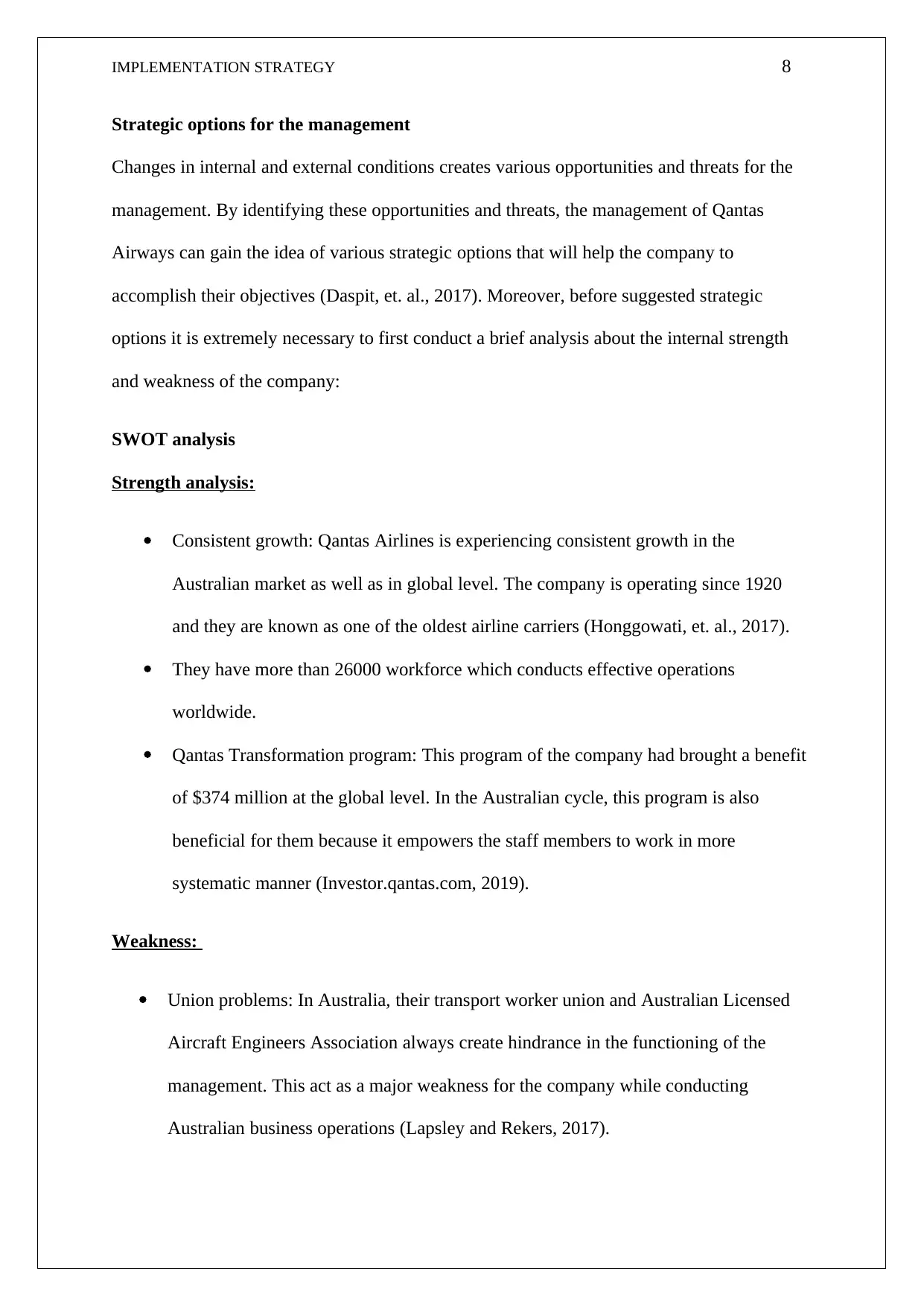
IMPLEMENTATION STRATEGY 8
Strategic options for the management
Changes in internal and external conditions creates various opportunities and threats for the
management. By identifying these opportunities and threats, the management of Qantas
Airways can gain the idea of various strategic options that will help the company to
accomplish their objectives (Daspit, et. al., 2017). Moreover, before suggested strategic
options it is extremely necessary to first conduct a brief analysis about the internal strength
and weakness of the company:
SWOT analysis
Strength analysis:
Consistent growth: Qantas Airlines is experiencing consistent growth in the
Australian market as well as in global level. The company is operating since 1920
and they are known as one of the oldest airline carriers (Honggowati, et. al., 2017).
They have more than 26000 workforce which conducts effective operations
worldwide.
Qantas Transformation program: This program of the company had brought a benefit
of $374 million at the global level. In the Australian cycle, this program is also
beneficial for them because it empowers the staff members to work in more
systematic manner (Investor.qantas.com, 2019).
Weakness:
Union problems: In Australia, their transport worker union and Australian Licensed
Aircraft Engineers Association always create hindrance in the functioning of the
management. This act as a major weakness for the company while conducting
Australian business operations (Lapsley and Rekers, 2017).
Strategic options for the management
Changes in internal and external conditions creates various opportunities and threats for the
management. By identifying these opportunities and threats, the management of Qantas
Airways can gain the idea of various strategic options that will help the company to
accomplish their objectives (Daspit, et. al., 2017). Moreover, before suggested strategic
options it is extremely necessary to first conduct a brief analysis about the internal strength
and weakness of the company:
SWOT analysis
Strength analysis:
Consistent growth: Qantas Airlines is experiencing consistent growth in the
Australian market as well as in global level. The company is operating since 1920
and they are known as one of the oldest airline carriers (Honggowati, et. al., 2017).
They have more than 26000 workforce which conducts effective operations
worldwide.
Qantas Transformation program: This program of the company had brought a benefit
of $374 million at the global level. In the Australian cycle, this program is also
beneficial for them because it empowers the staff members to work in more
systematic manner (Investor.qantas.com, 2019).
Weakness:
Union problems: In Australia, their transport worker union and Australian Licensed
Aircraft Engineers Association always create hindrance in the functioning of the
management. This act as a major weakness for the company while conducting
Australian business operations (Lapsley and Rekers, 2017).
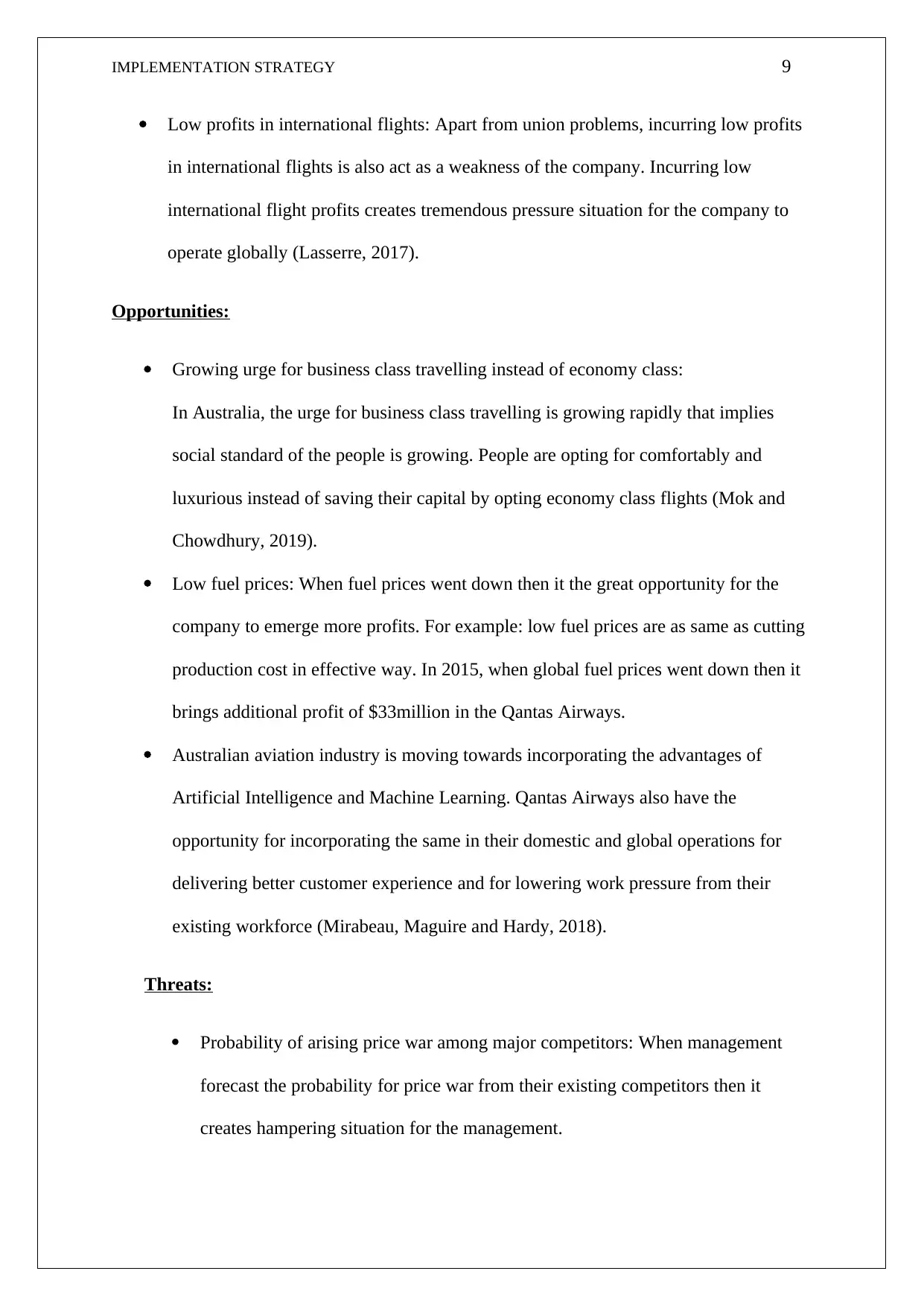
IMPLEMENTATION STRATEGY 9
Low profits in international flights: Apart from union problems, incurring low profits
in international flights is also act as a weakness of the company. Incurring low
international flight profits creates tremendous pressure situation for the company to
operate globally (Lasserre, 2017).
Opportunities:
Growing urge for business class travelling instead of economy class:
In Australia, the urge for business class travelling is growing rapidly that implies
social standard of the people is growing. People are opting for comfortably and
luxurious instead of saving their capital by opting economy class flights (Mok and
Chowdhury, 2019).
Low fuel prices: When fuel prices went down then it the great opportunity for the
company to emerge more profits. For example: low fuel prices are as same as cutting
production cost in effective way. In 2015, when global fuel prices went down then it
brings additional profit of $33million in the Qantas Airways.
Australian aviation industry is moving towards incorporating the advantages of
Artificial Intelligence and Machine Learning. Qantas Airways also have the
opportunity for incorporating the same in their domestic and global operations for
delivering better customer experience and for lowering work pressure from their
existing workforce (Mirabeau, Maguire and Hardy, 2018).
Threats:
Probability of arising price war among major competitors: When management
forecast the probability for price war from their existing competitors then it
creates hampering situation for the management.
Low profits in international flights: Apart from union problems, incurring low profits
in international flights is also act as a weakness of the company. Incurring low
international flight profits creates tremendous pressure situation for the company to
operate globally (Lasserre, 2017).
Opportunities:
Growing urge for business class travelling instead of economy class:
In Australia, the urge for business class travelling is growing rapidly that implies
social standard of the people is growing. People are opting for comfortably and
luxurious instead of saving their capital by opting economy class flights (Mok and
Chowdhury, 2019).
Low fuel prices: When fuel prices went down then it the great opportunity for the
company to emerge more profits. For example: low fuel prices are as same as cutting
production cost in effective way. In 2015, when global fuel prices went down then it
brings additional profit of $33million in the Qantas Airways.
Australian aviation industry is moving towards incorporating the advantages of
Artificial Intelligence and Machine Learning. Qantas Airways also have the
opportunity for incorporating the same in their domestic and global operations for
delivering better customer experience and for lowering work pressure from their
existing workforce (Mirabeau, Maguire and Hardy, 2018).
Threats:
Probability of arising price war among major competitors: When management
forecast the probability for price war from their existing competitors then it
creates hampering situation for the management.
Secure Best Marks with AI Grader
Need help grading? Try our AI Grader for instant feedback on your assignments.
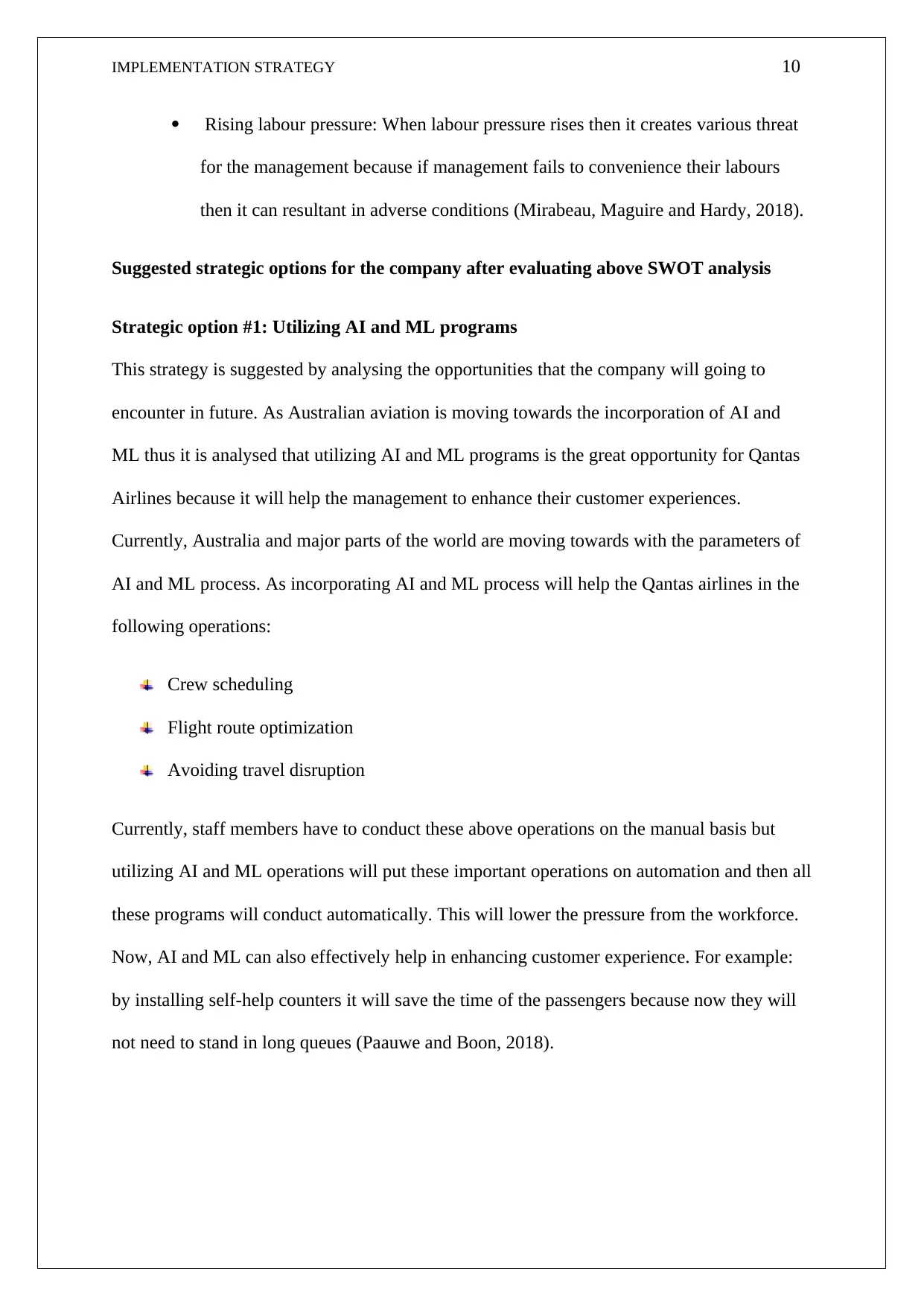
IMPLEMENTATION STRATEGY 10
Rising labour pressure: When labour pressure rises then it creates various threat
for the management because if management fails to convenience their labours
then it can resultant in adverse conditions (Mirabeau, Maguire and Hardy, 2018).
Suggested strategic options for the company after evaluating above SWOT analysis
Strategic option #1: Utilizing AI and ML programs
This strategy is suggested by analysing the opportunities that the company will going to
encounter in future. As Australian aviation is moving towards the incorporation of AI and
ML thus it is analysed that utilizing AI and ML programs is the great opportunity for Qantas
Airlines because it will help the management to enhance their customer experiences.
Currently, Australia and major parts of the world are moving towards with the parameters of
AI and ML process. As incorporating AI and ML process will help the Qantas airlines in the
following operations:
Crew scheduling
Flight route optimization
Avoiding travel disruption
Currently, staff members have to conduct these above operations on the manual basis but
utilizing AI and ML operations will put these important operations on automation and then all
these programs will conduct automatically. This will lower the pressure from the workforce.
Now, AI and ML can also effectively help in enhancing customer experience. For example:
by installing self-help counters it will save the time of the passengers because now they will
not need to stand in long queues (Paauwe and Boon, 2018).
Rising labour pressure: When labour pressure rises then it creates various threat
for the management because if management fails to convenience their labours
then it can resultant in adverse conditions (Mirabeau, Maguire and Hardy, 2018).
Suggested strategic options for the company after evaluating above SWOT analysis
Strategic option #1: Utilizing AI and ML programs
This strategy is suggested by analysing the opportunities that the company will going to
encounter in future. As Australian aviation is moving towards the incorporation of AI and
ML thus it is analysed that utilizing AI and ML programs is the great opportunity for Qantas
Airlines because it will help the management to enhance their customer experiences.
Currently, Australia and major parts of the world are moving towards with the parameters of
AI and ML process. As incorporating AI and ML process will help the Qantas airlines in the
following operations:
Crew scheduling
Flight route optimization
Avoiding travel disruption
Currently, staff members have to conduct these above operations on the manual basis but
utilizing AI and ML operations will put these important operations on automation and then all
these programs will conduct automatically. This will lower the pressure from the workforce.
Now, AI and ML can also effectively help in enhancing customer experience. For example:
by installing self-help counters it will save the time of the passengers because now they will
not need to stand in long queues (Paauwe and Boon, 2018).
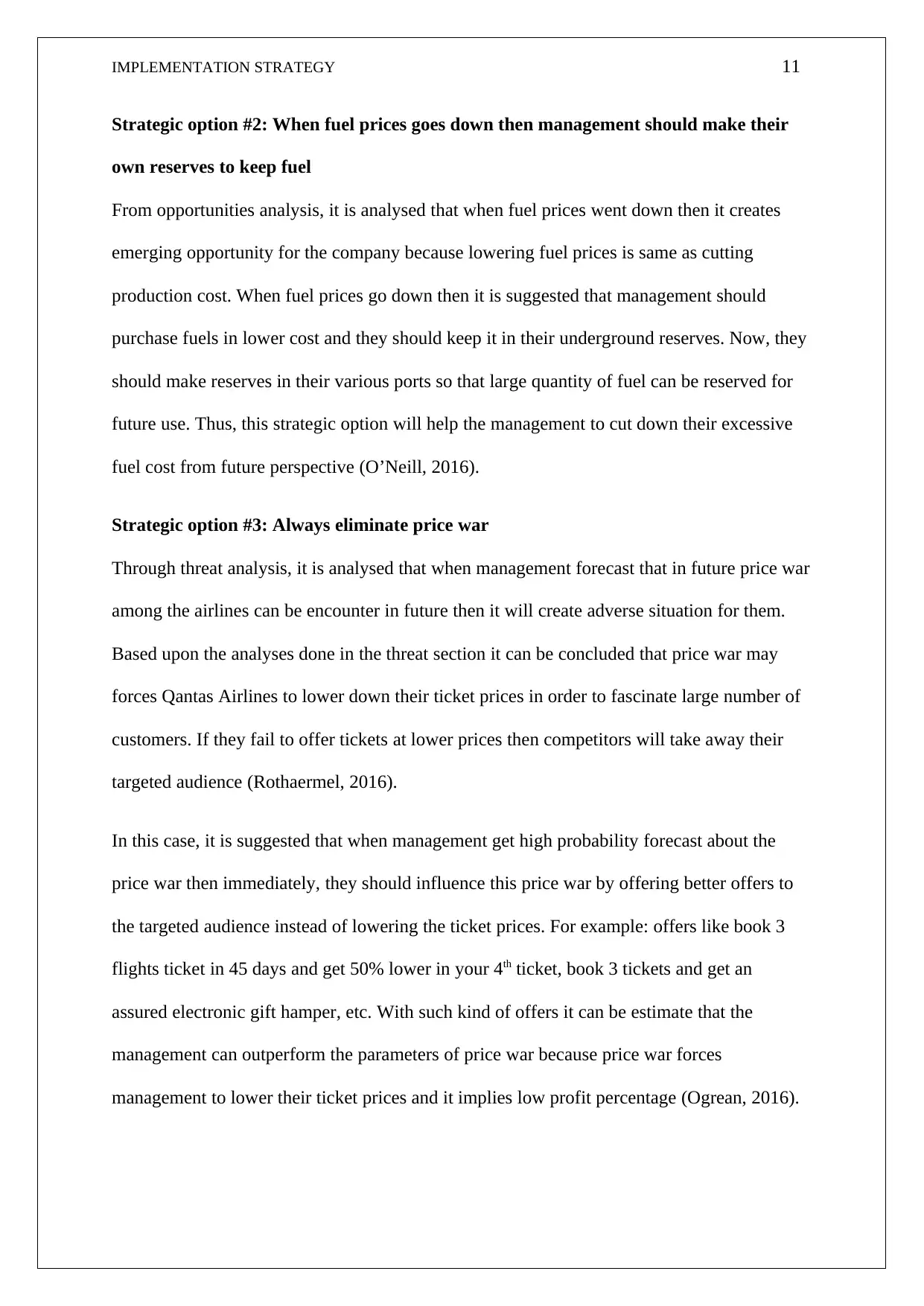
IMPLEMENTATION STRATEGY 11
Strategic option #2: When fuel prices goes down then management should make their
own reserves to keep fuel
From opportunities analysis, it is analysed that when fuel prices went down then it creates
emerging opportunity for the company because lowering fuel prices is same as cutting
production cost. When fuel prices go down then it is suggested that management should
purchase fuels in lower cost and they should keep it in their underground reserves. Now, they
should make reserves in their various ports so that large quantity of fuel can be reserved for
future use. Thus, this strategic option will help the management to cut down their excessive
fuel cost from future perspective (O’Neill, 2016).
Strategic option #3: Always eliminate price war
Through threat analysis, it is analysed that when management forecast that in future price war
among the airlines can be encounter in future then it will create adverse situation for them.
Based upon the analyses done in the threat section it can be concluded that price war may
forces Qantas Airlines to lower down their ticket prices in order to fascinate large number of
customers. If they fail to offer tickets at lower prices then competitors will take away their
targeted audience (Rothaermel, 2016).
In this case, it is suggested that when management get high probability forecast about the
price war then immediately, they should influence this price war by offering better offers to
the targeted audience instead of lowering the ticket prices. For example: offers like book 3
flights ticket in 45 days and get 50% lower in your 4th ticket, book 3 tickets and get an
assured electronic gift hamper, etc. With such kind of offers it can be estimate that the
management can outperform the parameters of price war because price war forces
management to lower their ticket prices and it implies low profit percentage (Ogrean, 2016).
Strategic option #2: When fuel prices goes down then management should make their
own reserves to keep fuel
From opportunities analysis, it is analysed that when fuel prices went down then it creates
emerging opportunity for the company because lowering fuel prices is same as cutting
production cost. When fuel prices go down then it is suggested that management should
purchase fuels in lower cost and they should keep it in their underground reserves. Now, they
should make reserves in their various ports so that large quantity of fuel can be reserved for
future use. Thus, this strategic option will help the management to cut down their excessive
fuel cost from future perspective (O’Neill, 2016).
Strategic option #3: Always eliminate price war
Through threat analysis, it is analysed that when management forecast that in future price war
among the airlines can be encounter in future then it will create adverse situation for them.
Based upon the analyses done in the threat section it can be concluded that price war may
forces Qantas Airlines to lower down their ticket prices in order to fascinate large number of
customers. If they fail to offer tickets at lower prices then competitors will take away their
targeted audience (Rothaermel, 2016).
In this case, it is suggested that when management get high probability forecast about the
price war then immediately, they should influence this price war by offering better offers to
the targeted audience instead of lowering the ticket prices. For example: offers like book 3
flights ticket in 45 days and get 50% lower in your 4th ticket, book 3 tickets and get an
assured electronic gift hamper, etc. With such kind of offers it can be estimate that the
management can outperform the parameters of price war because price war forces
management to lower their ticket prices and it implies low profit percentage (Ogrean, 2016).
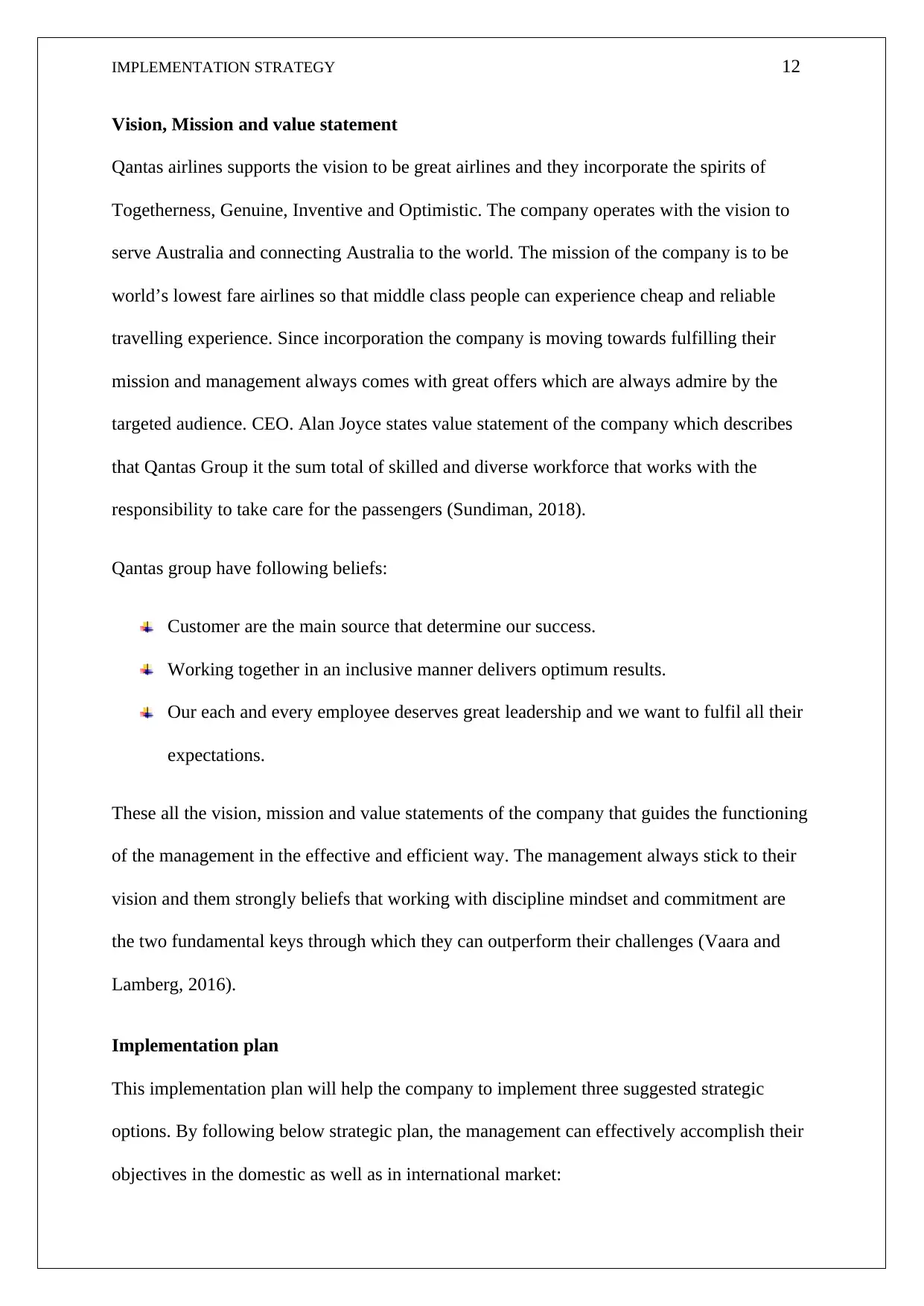
IMPLEMENTATION STRATEGY 12
Vision, Mission and value statement
Qantas airlines supports the vision to be great airlines and they incorporate the spirits of
Togetherness, Genuine, Inventive and Optimistic. The company operates with the vision to
serve Australia and connecting Australia to the world. The mission of the company is to be
world’s lowest fare airlines so that middle class people can experience cheap and reliable
travelling experience. Since incorporation the company is moving towards fulfilling their
mission and management always comes with great offers which are always admire by the
targeted audience. CEO. Alan Joyce states value statement of the company which describes
that Qantas Group it the sum total of skilled and diverse workforce that works with the
responsibility to take care for the passengers (Sundiman, 2018).
Qantas group have following beliefs:
Customer are the main source that determine our success.
Working together in an inclusive manner delivers optimum results.
Our each and every employee deserves great leadership and we want to fulfil all their
expectations.
These all the vision, mission and value statements of the company that guides the functioning
of the management in the effective and efficient way. The management always stick to their
vision and them strongly beliefs that working with discipline mindset and commitment are
the two fundamental keys through which they can outperform their challenges (Vaara and
Lamberg, 2016).
Implementation plan
This implementation plan will help the company to implement three suggested strategic
options. By following below strategic plan, the management can effectively accomplish their
objectives in the domestic as well as in international market:
Vision, Mission and value statement
Qantas airlines supports the vision to be great airlines and they incorporate the spirits of
Togetherness, Genuine, Inventive and Optimistic. The company operates with the vision to
serve Australia and connecting Australia to the world. The mission of the company is to be
world’s lowest fare airlines so that middle class people can experience cheap and reliable
travelling experience. Since incorporation the company is moving towards fulfilling their
mission and management always comes with great offers which are always admire by the
targeted audience. CEO. Alan Joyce states value statement of the company which describes
that Qantas Group it the sum total of skilled and diverse workforce that works with the
responsibility to take care for the passengers (Sundiman, 2018).
Qantas group have following beliefs:
Customer are the main source that determine our success.
Working together in an inclusive manner delivers optimum results.
Our each and every employee deserves great leadership and we want to fulfil all their
expectations.
These all the vision, mission and value statements of the company that guides the functioning
of the management in the effective and efficient way. The management always stick to their
vision and them strongly beliefs that working with discipline mindset and commitment are
the two fundamental keys through which they can outperform their challenges (Vaara and
Lamberg, 2016).
Implementation plan
This implementation plan will help the company to implement three suggested strategic
options. By following below strategic plan, the management can effectively accomplish their
objectives in the domestic as well as in international market:
Paraphrase This Document
Need a fresh take? Get an instant paraphrase of this document with our AI Paraphraser
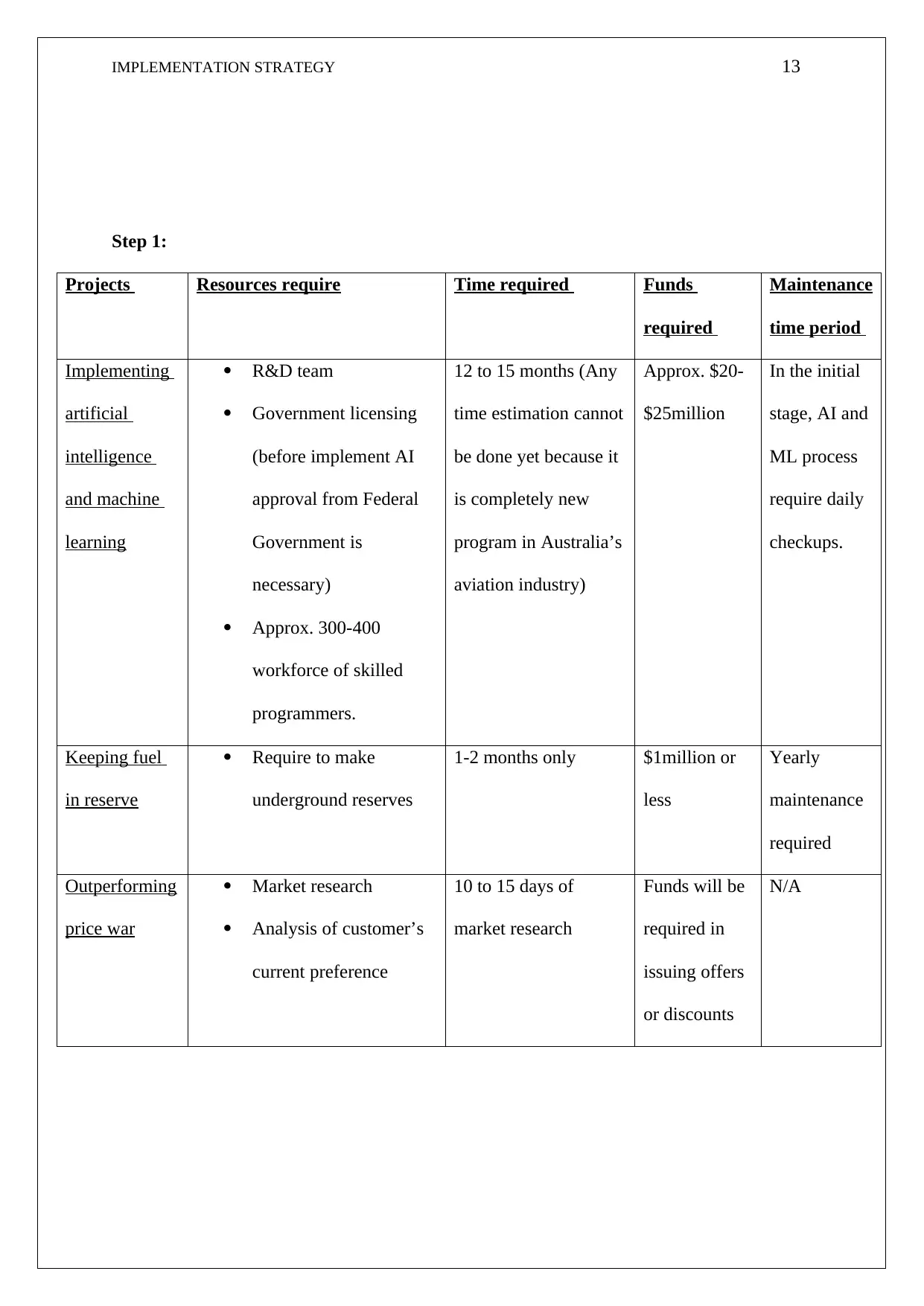
IMPLEMENTATION STRATEGY 13
Step 1:
Projects Resources require Time required Funds
required
Maintenance
time period
Implementing
artificial
intelligence
and machine
learning
R&D team
Government licensing
(before implement AI
approval from Federal
Government is
necessary)
Approx. 300-400
workforce of skilled
programmers.
12 to 15 months (Any
time estimation cannot
be done yet because it
is completely new
program in Australia’s
aviation industry)
Approx. $20-
$25million
In the initial
stage, AI and
ML process
require daily
checkups.
Keeping fuel
in reserve
Require to make
underground reserves
1-2 months only $1million or
less
Yearly
maintenance
required
Outperforming
price war
Market research
Analysis of customer’s
current preference
10 to 15 days of
market research
Funds will be
required in
issuing offers
or discounts
N/A
Step 1:
Projects Resources require Time required Funds
required
Maintenance
time period
Implementing
artificial
intelligence
and machine
learning
R&D team
Government licensing
(before implement AI
approval from Federal
Government is
necessary)
Approx. 300-400
workforce of skilled
programmers.
12 to 15 months (Any
time estimation cannot
be done yet because it
is completely new
program in Australia’s
aviation industry)
Approx. $20-
$25million
In the initial
stage, AI and
ML process
require daily
checkups.
Keeping fuel
in reserve
Require to make
underground reserves
1-2 months only $1million or
less
Yearly
maintenance
required
Outperforming
price war
Market research
Analysis of customer’s
current preference
10 to 15 days of
market research
Funds will be
required in
issuing offers
or discounts
N/A
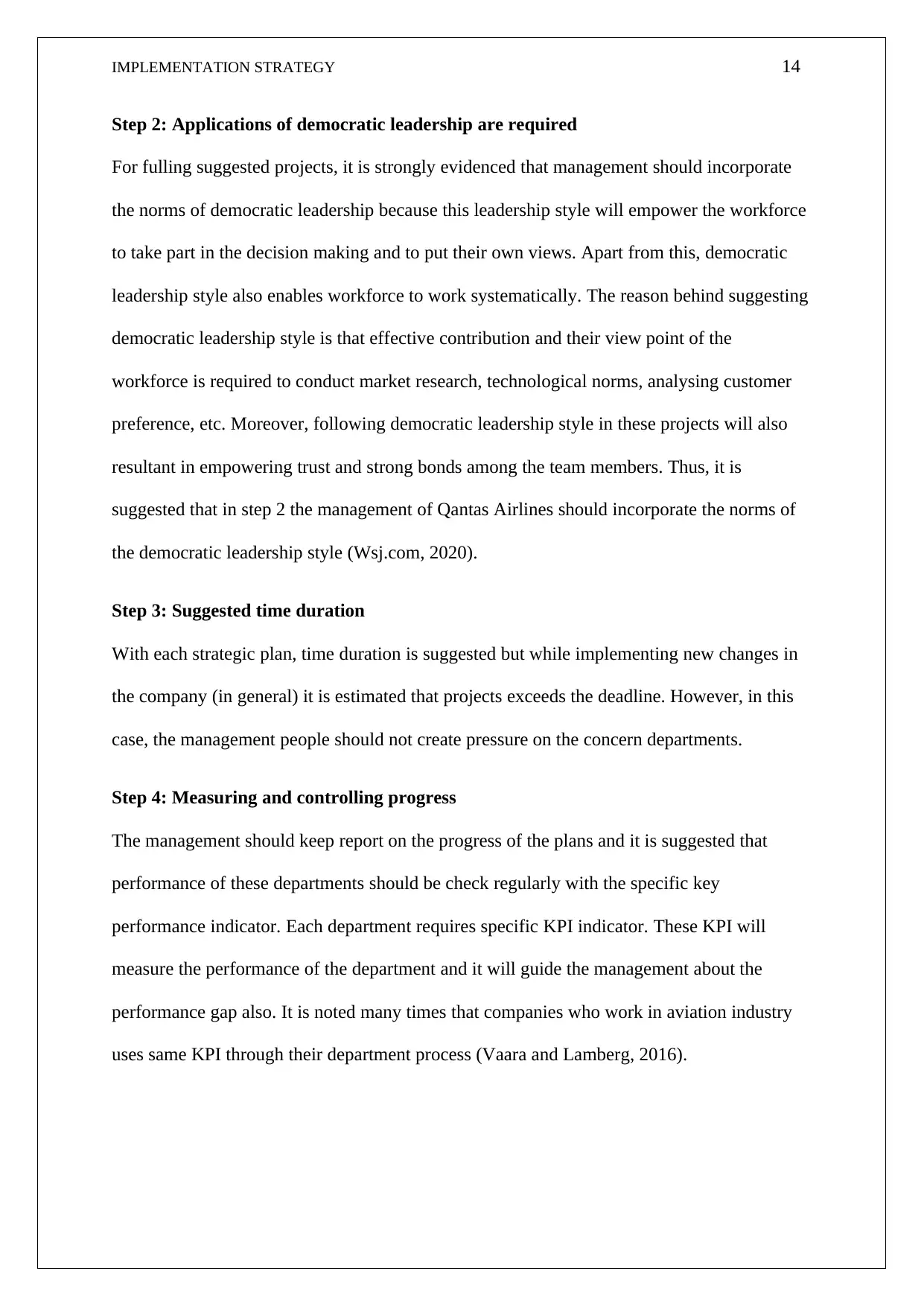
IMPLEMENTATION STRATEGY 14
Step 2: Applications of democratic leadership are required
For fulling suggested projects, it is strongly evidenced that management should incorporate
the norms of democratic leadership because this leadership style will empower the workforce
to take part in the decision making and to put their own views. Apart from this, democratic
leadership style also enables workforce to work systematically. The reason behind suggesting
democratic leadership style is that effective contribution and their view point of the
workforce is required to conduct market research, technological norms, analysing customer
preference, etc. Moreover, following democratic leadership style in these projects will also
resultant in empowering trust and strong bonds among the team members. Thus, it is
suggested that in step 2 the management of Qantas Airlines should incorporate the norms of
the democratic leadership style (Wsj.com, 2020).
Step 3: Suggested time duration
With each strategic plan, time duration is suggested but while implementing new changes in
the company (in general) it is estimated that projects exceeds the deadline. However, in this
case, the management people should not create pressure on the concern departments.
Step 4: Measuring and controlling progress
The management should keep report on the progress of the plans and it is suggested that
performance of these departments should be check regularly with the specific key
performance indicator. Each department requires specific KPI indicator. These KPI will
measure the performance of the department and it will guide the management about the
performance gap also. It is noted many times that companies who work in aviation industry
uses same KPI through their department process (Vaara and Lamberg, 2016).
Step 2: Applications of democratic leadership are required
For fulling suggested projects, it is strongly evidenced that management should incorporate
the norms of democratic leadership because this leadership style will empower the workforce
to take part in the decision making and to put their own views. Apart from this, democratic
leadership style also enables workforce to work systematically. The reason behind suggesting
democratic leadership style is that effective contribution and their view point of the
workforce is required to conduct market research, technological norms, analysing customer
preference, etc. Moreover, following democratic leadership style in these projects will also
resultant in empowering trust and strong bonds among the team members. Thus, it is
suggested that in step 2 the management of Qantas Airlines should incorporate the norms of
the democratic leadership style (Wsj.com, 2020).
Step 3: Suggested time duration
With each strategic plan, time duration is suggested but while implementing new changes in
the company (in general) it is estimated that projects exceeds the deadline. However, in this
case, the management people should not create pressure on the concern departments.
Step 4: Measuring and controlling progress
The management should keep report on the progress of the plans and it is suggested that
performance of these departments should be check regularly with the specific key
performance indicator. Each department requires specific KPI indicator. These KPI will
measure the performance of the department and it will guide the management about the
performance gap also. It is noted many times that companies who work in aviation industry
uses same KPI through their department process (Vaara and Lamberg, 2016).
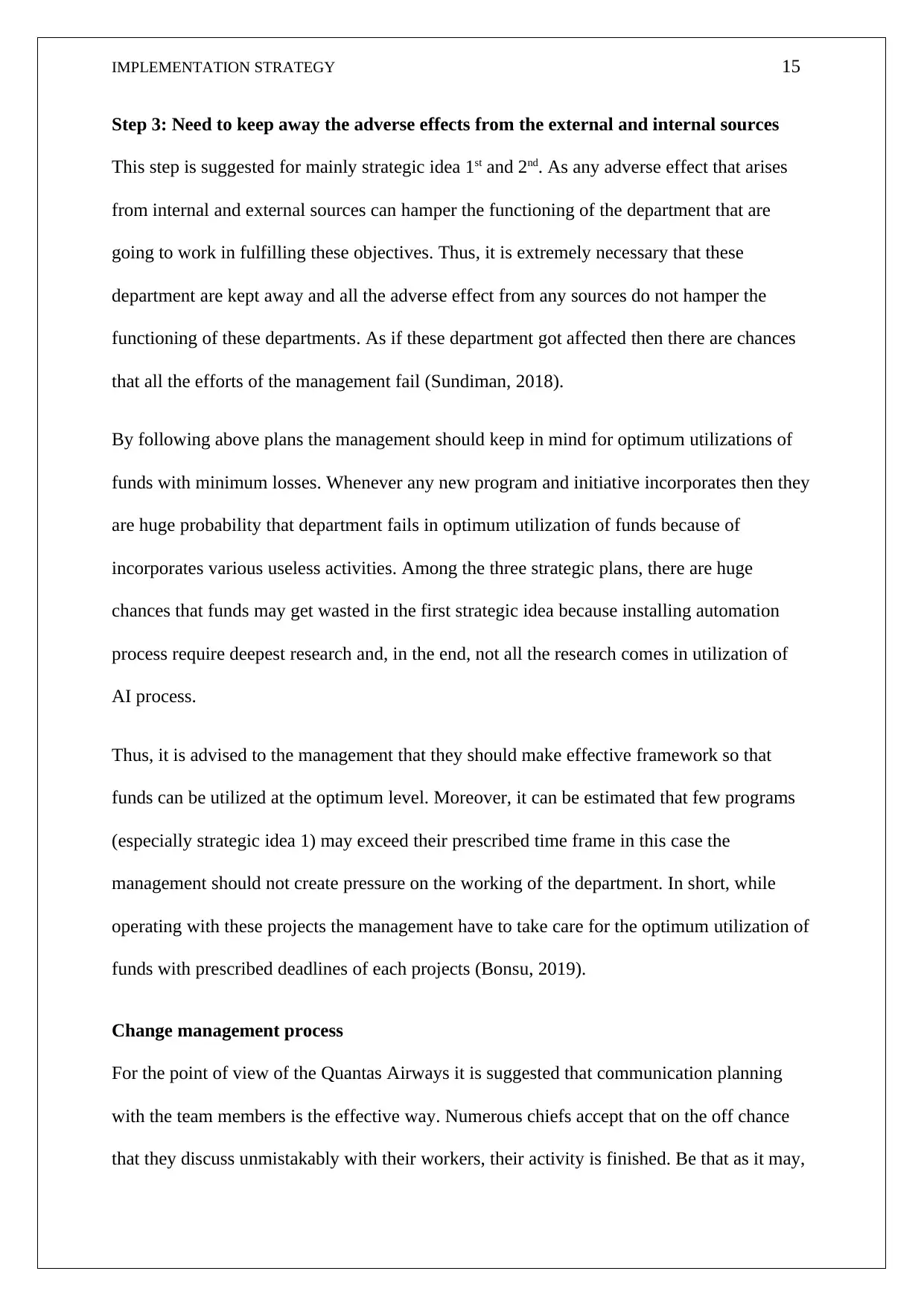
IMPLEMENTATION STRATEGY 15
Step 3: Need to keep away the adverse effects from the external and internal sources
This step is suggested for mainly strategic idea 1st and 2nd. As any adverse effect that arises
from internal and external sources can hamper the functioning of the department that are
going to work in fulfilling these objectives. Thus, it is extremely necessary that these
department are kept away and all the adverse effect from any sources do not hamper the
functioning of these departments. As if these department got affected then there are chances
that all the efforts of the management fail (Sundiman, 2018).
By following above plans the management should keep in mind for optimum utilizations of
funds with minimum losses. Whenever any new program and initiative incorporates then they
are huge probability that department fails in optimum utilization of funds because of
incorporates various useless activities. Among the three strategic plans, there are huge
chances that funds may get wasted in the first strategic idea because installing automation
process require deepest research and, in the end, not all the research comes in utilization of
AI process.
Thus, it is advised to the management that they should make effective framework so that
funds can be utilized at the optimum level. Moreover, it can be estimated that few programs
(especially strategic idea 1) may exceed their prescribed time frame in this case the
management should not create pressure on the working of the department. In short, while
operating with these projects the management have to take care for the optimum utilization of
funds with prescribed deadlines of each projects (Bonsu, 2019).
Change management process
For the point of view of the Quantas Airways it is suggested that communication planning
with the team members is the effective way. Numerous chiefs accept that on the off chance
that they discuss unmistakably with their workers, their activity is finished. Be that as it may,
Step 3: Need to keep away the adverse effects from the external and internal sources
This step is suggested for mainly strategic idea 1st and 2nd. As any adverse effect that arises
from internal and external sources can hamper the functioning of the department that are
going to work in fulfilling these objectives. Thus, it is extremely necessary that these
department are kept away and all the adverse effect from any sources do not hamper the
functioning of these departments. As if these department got affected then there are chances
that all the efforts of the management fail (Sundiman, 2018).
By following above plans the management should keep in mind for optimum utilizations of
funds with minimum losses. Whenever any new program and initiative incorporates then they
are huge probability that department fails in optimum utilization of funds because of
incorporates various useless activities. Among the three strategic plans, there are huge
chances that funds may get wasted in the first strategic idea because installing automation
process require deepest research and, in the end, not all the research comes in utilization of
AI process.
Thus, it is advised to the management that they should make effective framework so that
funds can be utilized at the optimum level. Moreover, it can be estimated that few programs
(especially strategic idea 1) may exceed their prescribed time frame in this case the
management should not create pressure on the working of the department. In short, while
operating with these projects the management have to take care for the optimum utilization of
funds with prescribed deadlines of each projects (Bonsu, 2019).
Change management process
For the point of view of the Quantas Airways it is suggested that communication planning
with the team members is the effective way. Numerous chiefs accept that on the off chance
that they discuss unmistakably with their workers, their activity is finished. Be that as it may,
Secure Best Marks with AI Grader
Need help grading? Try our AI Grader for instant feedback on your assignments.
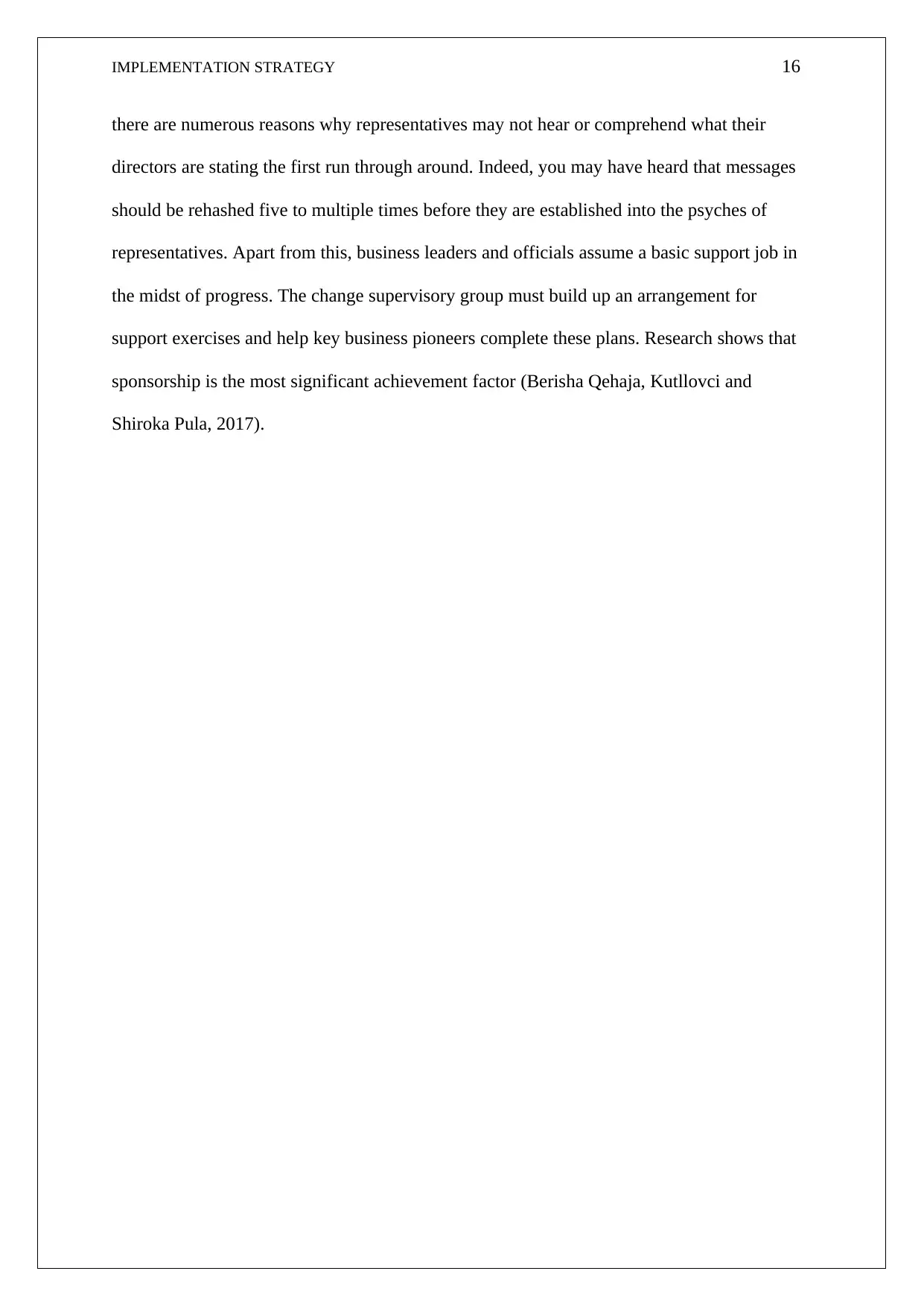
IMPLEMENTATION STRATEGY 16
there are numerous reasons why representatives may not hear or comprehend what their
directors are stating the first run through around. Indeed, you may have heard that messages
should be rehashed five to multiple times before they are established into the psyches of
representatives. Apart from this, business leaders and officials assume a basic support job in
the midst of progress. The change supervisory group must build up an arrangement for
support exercises and help key business pioneers complete these plans. Research shows that
sponsorship is the most significant achievement factor (Berisha Qehaja, Kutllovci and
Shiroka Pula, 2017).
there are numerous reasons why representatives may not hear or comprehend what their
directors are stating the first run through around. Indeed, you may have heard that messages
should be rehashed five to multiple times before they are established into the psyches of
representatives. Apart from this, business leaders and officials assume a basic support job in
the midst of progress. The change supervisory group must build up an arrangement for
support exercises and help key business pioneers complete these plans. Research shows that
sponsorship is the most significant achievement factor (Berisha Qehaja, Kutllovci and
Shiroka Pula, 2017).
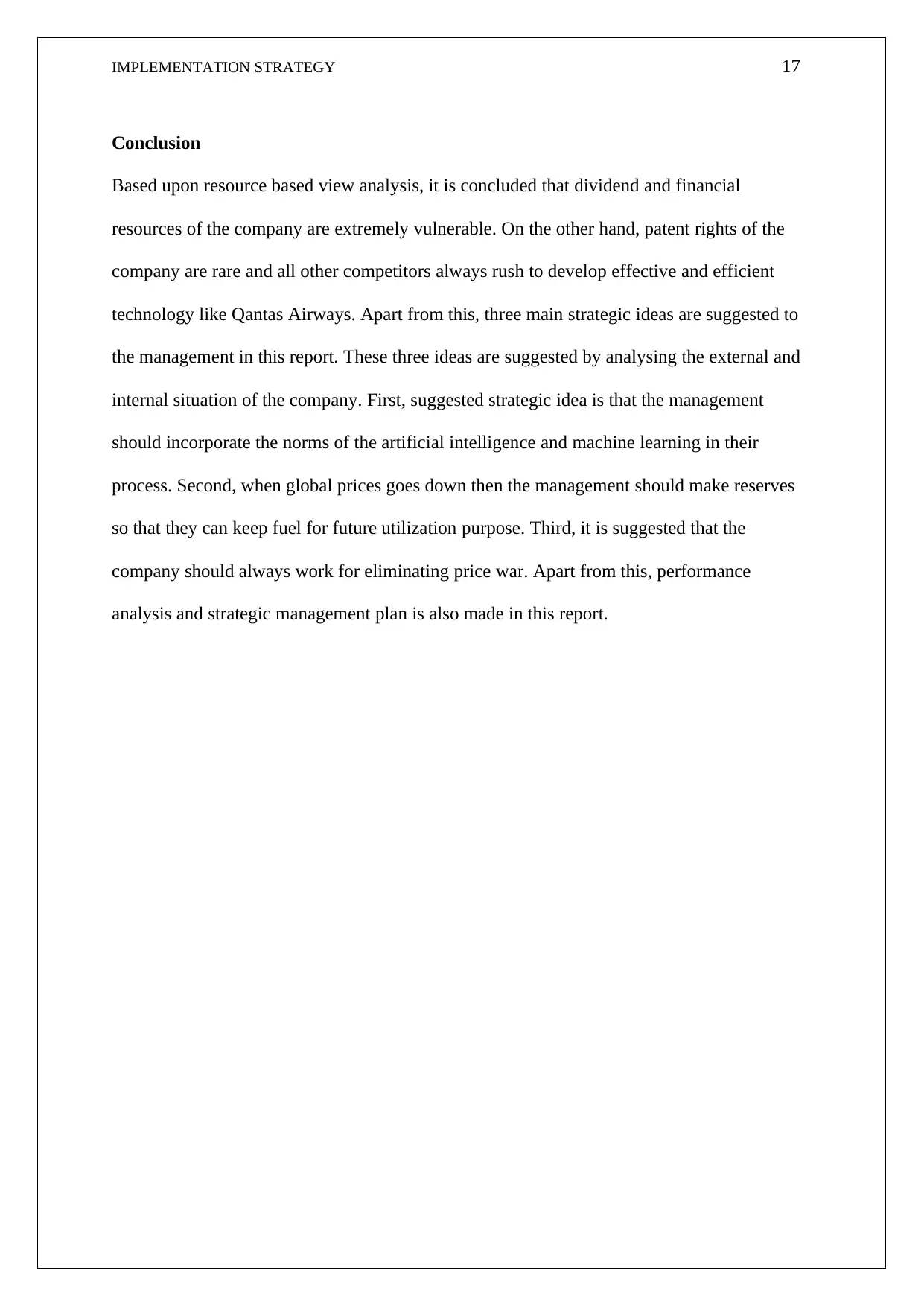
IMPLEMENTATION STRATEGY 17
Conclusion
Based upon resource based view analysis, it is concluded that dividend and financial
resources of the company are extremely vulnerable. On the other hand, patent rights of the
company are rare and all other competitors always rush to develop effective and efficient
technology like Qantas Airways. Apart from this, three main strategic ideas are suggested to
the management in this report. These three ideas are suggested by analysing the external and
internal situation of the company. First, suggested strategic idea is that the management
should incorporate the norms of the artificial intelligence and machine learning in their
process. Second, when global prices goes down then the management should make reserves
so that they can keep fuel for future utilization purpose. Third, it is suggested that the
company should always work for eliminating price war. Apart from this, performance
analysis and strategic management plan is also made in this report.
Conclusion
Based upon resource based view analysis, it is concluded that dividend and financial
resources of the company are extremely vulnerable. On the other hand, patent rights of the
company are rare and all other competitors always rush to develop effective and efficient
technology like Qantas Airways. Apart from this, three main strategic ideas are suggested to
the management in this report. These three ideas are suggested by analysing the external and
internal situation of the company. First, suggested strategic idea is that the management
should incorporate the norms of the artificial intelligence and machine learning in their
process. Second, when global prices goes down then the management should make reserves
so that they can keep fuel for future utilization purpose. Third, it is suggested that the
company should always work for eliminating price war. Apart from this, performance
analysis and strategic management plan is also made in this report.
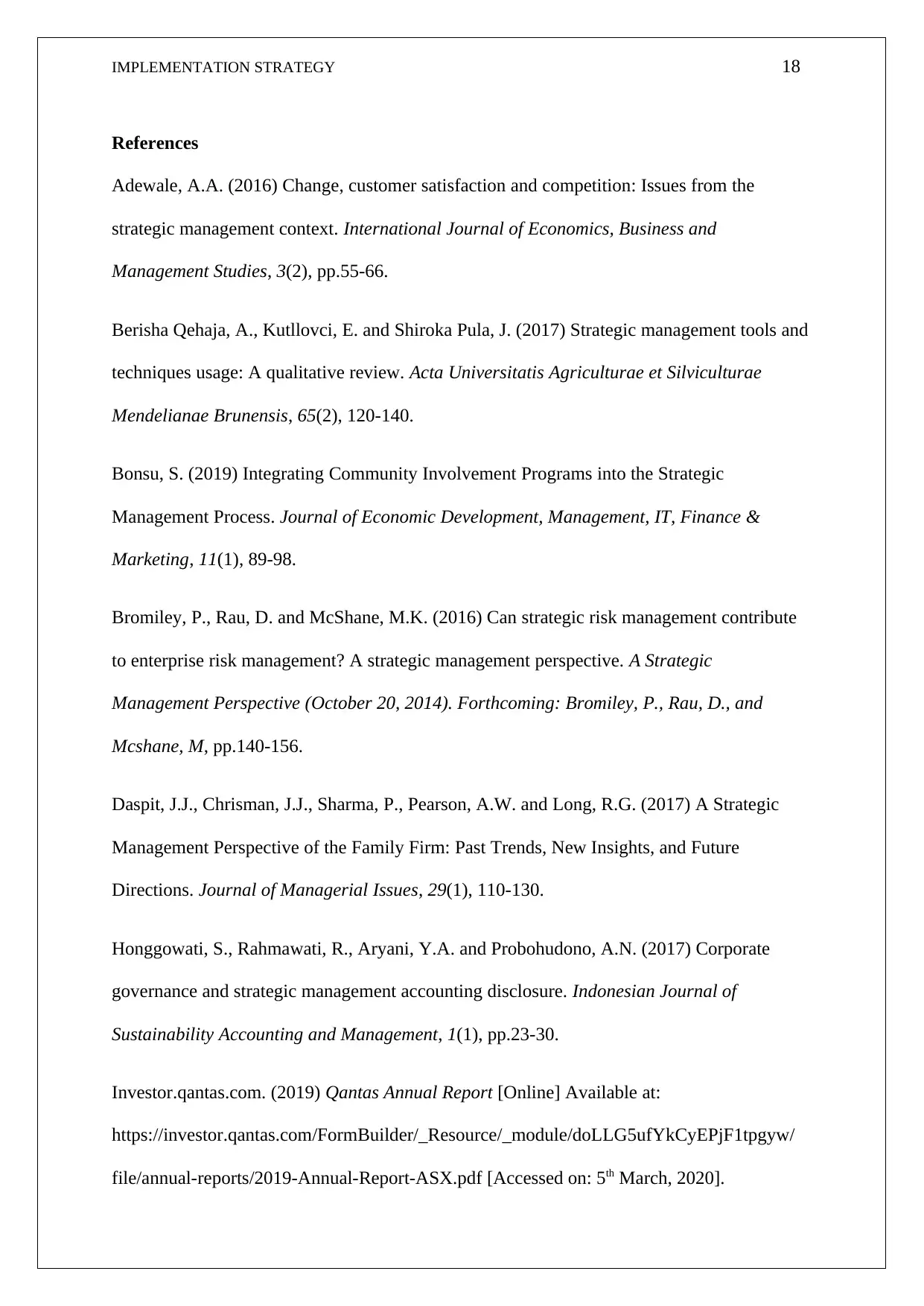
IMPLEMENTATION STRATEGY 18
References
Adewale, A.A. (2016) Change, customer satisfaction and competition: Issues from the
strategic management context. International Journal of Economics, Business and
Management Studies, 3(2), pp.55-66.
Berisha Qehaja, A., Kutllovci, E. and Shiroka Pula, J. (2017) Strategic management tools and
techniques usage: A qualitative review. Acta Universitatis Agriculturae et Silviculturae
Mendelianae Brunensis, 65(2), 120-140.
Bonsu, S. (2019) Integrating Community Involvement Programs into the Strategic
Management Process. Journal of Economic Development, Management, IT, Finance &
Marketing, 11(1), 89-98.
Bromiley, P., Rau, D. and McShane, M.K. (2016) Can strategic risk management contribute
to enterprise risk management? A strategic management perspective. A Strategic
Management Perspective (October 20, 2014). Forthcoming: Bromiley, P., Rau, D., and
Mcshane, M, pp.140-156.
Daspit, J.J., Chrisman, J.J., Sharma, P., Pearson, A.W. and Long, R.G. (2017) A Strategic
Management Perspective of the Family Firm: Past Trends, New Insights, and Future
Directions. Journal of Managerial Issues, 29(1), 110-130.
Honggowati, S., Rahmawati, R., Aryani, Y.A. and Probohudono, A.N. (2017) Corporate
governance and strategic management accounting disclosure. Indonesian Journal of
Sustainability Accounting and Management, 1(1), pp.23-30.
Investor.qantas.com. (2019) Qantas Annual Report [Online] Available at:
https://investor.qantas.com/FormBuilder/_Resource/_module/doLLG5ufYkCyEPjF1tpgyw/
file/annual-reports/2019-Annual-Report-ASX.pdf [Accessed on: 5th March, 2020].
References
Adewale, A.A. (2016) Change, customer satisfaction and competition: Issues from the
strategic management context. International Journal of Economics, Business and
Management Studies, 3(2), pp.55-66.
Berisha Qehaja, A., Kutllovci, E. and Shiroka Pula, J. (2017) Strategic management tools and
techniques usage: A qualitative review. Acta Universitatis Agriculturae et Silviculturae
Mendelianae Brunensis, 65(2), 120-140.
Bonsu, S. (2019) Integrating Community Involvement Programs into the Strategic
Management Process. Journal of Economic Development, Management, IT, Finance &
Marketing, 11(1), 89-98.
Bromiley, P., Rau, D. and McShane, M.K. (2016) Can strategic risk management contribute
to enterprise risk management? A strategic management perspective. A Strategic
Management Perspective (October 20, 2014). Forthcoming: Bromiley, P., Rau, D., and
Mcshane, M, pp.140-156.
Daspit, J.J., Chrisman, J.J., Sharma, P., Pearson, A.W. and Long, R.G. (2017) A Strategic
Management Perspective of the Family Firm: Past Trends, New Insights, and Future
Directions. Journal of Managerial Issues, 29(1), 110-130.
Honggowati, S., Rahmawati, R., Aryani, Y.A. and Probohudono, A.N. (2017) Corporate
governance and strategic management accounting disclosure. Indonesian Journal of
Sustainability Accounting and Management, 1(1), pp.23-30.
Investor.qantas.com. (2019) Qantas Annual Report [Online] Available at:
https://investor.qantas.com/FormBuilder/_Resource/_module/doLLG5ufYkCyEPjF1tpgyw/
file/annual-reports/2019-Annual-Report-ASX.pdf [Accessed on: 5th March, 2020].
Paraphrase This Document
Need a fresh take? Get an instant paraphrase of this document with our AI Paraphraser
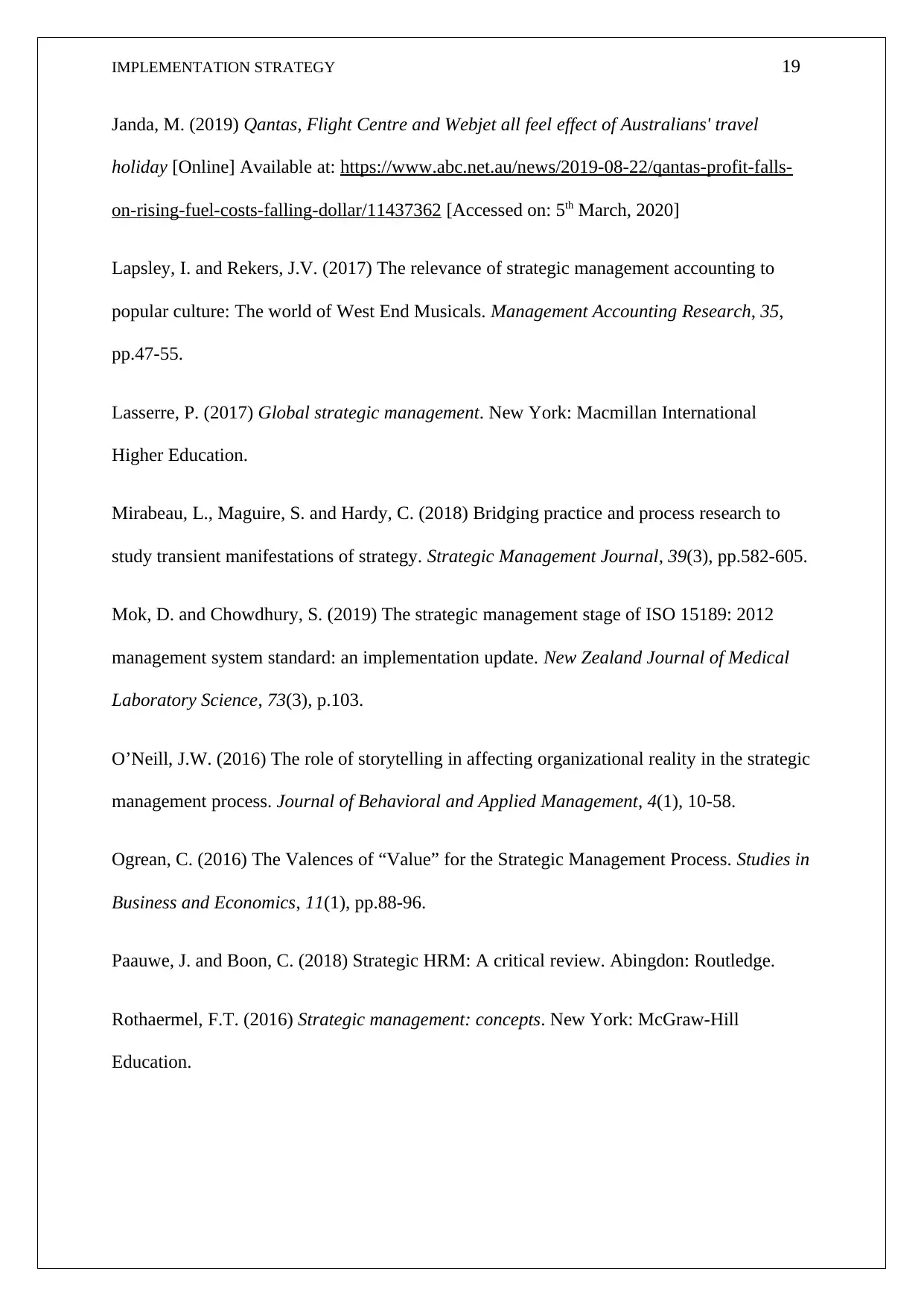
IMPLEMENTATION STRATEGY 19
Janda, M. (2019) Qantas, Flight Centre and Webjet all feel effect of Australians' travel
holiday [Online] Available at: https://www.abc.net.au/news/2019-08-22/qantas-profit-falls-
on-rising-fuel-costs-falling-dollar/11437362 [Accessed on: 5th March, 2020]
Lapsley, I. and Rekers, J.V. (2017) The relevance of strategic management accounting to
popular culture: The world of West End Musicals. Management Accounting Research, 35,
pp.47-55.
Lasserre, P. (2017) Global strategic management. New York: Macmillan International
Higher Education.
Mirabeau, L., Maguire, S. and Hardy, C. (2018) Bridging practice and process research to
study transient manifestations of strategy. Strategic Management Journal, 39(3), pp.582-605.
Mok, D. and Chowdhury, S. (2019) The strategic management stage of ISO 15189: 2012
management system standard: an implementation update. New Zealand Journal of Medical
Laboratory Science, 73(3), p.103.
O’Neill, J.W. (2016) The role of storytelling in affecting organizational reality in the strategic
management process. Journal of Behavioral and Applied Management, 4(1), 10-58.
Ogrean, C. (2016) The Valences of “Value” for the Strategic Management Process. Studies in
Business and Economics, 11(1), pp.88-96.
Paauwe, J. and Boon, C. (2018) Strategic HRM: A critical review. Abingdon: Routledge.
Rothaermel, F.T. (2016) Strategic management: concepts. New York: McGraw-Hill
Education.
Janda, M. (2019) Qantas, Flight Centre and Webjet all feel effect of Australians' travel
holiday [Online] Available at: https://www.abc.net.au/news/2019-08-22/qantas-profit-falls-
on-rising-fuel-costs-falling-dollar/11437362 [Accessed on: 5th March, 2020]
Lapsley, I. and Rekers, J.V. (2017) The relevance of strategic management accounting to
popular culture: The world of West End Musicals. Management Accounting Research, 35,
pp.47-55.
Lasserre, P. (2017) Global strategic management. New York: Macmillan International
Higher Education.
Mirabeau, L., Maguire, S. and Hardy, C. (2018) Bridging practice and process research to
study transient manifestations of strategy. Strategic Management Journal, 39(3), pp.582-605.
Mok, D. and Chowdhury, S. (2019) The strategic management stage of ISO 15189: 2012
management system standard: an implementation update. New Zealand Journal of Medical
Laboratory Science, 73(3), p.103.
O’Neill, J.W. (2016) The role of storytelling in affecting organizational reality in the strategic
management process. Journal of Behavioral and Applied Management, 4(1), 10-58.
Ogrean, C. (2016) The Valences of “Value” for the Strategic Management Process. Studies in
Business and Economics, 11(1), pp.88-96.
Paauwe, J. and Boon, C. (2018) Strategic HRM: A critical review. Abingdon: Routledge.
Rothaermel, F.T. (2016) Strategic management: concepts. New York: McGraw-Hill
Education.
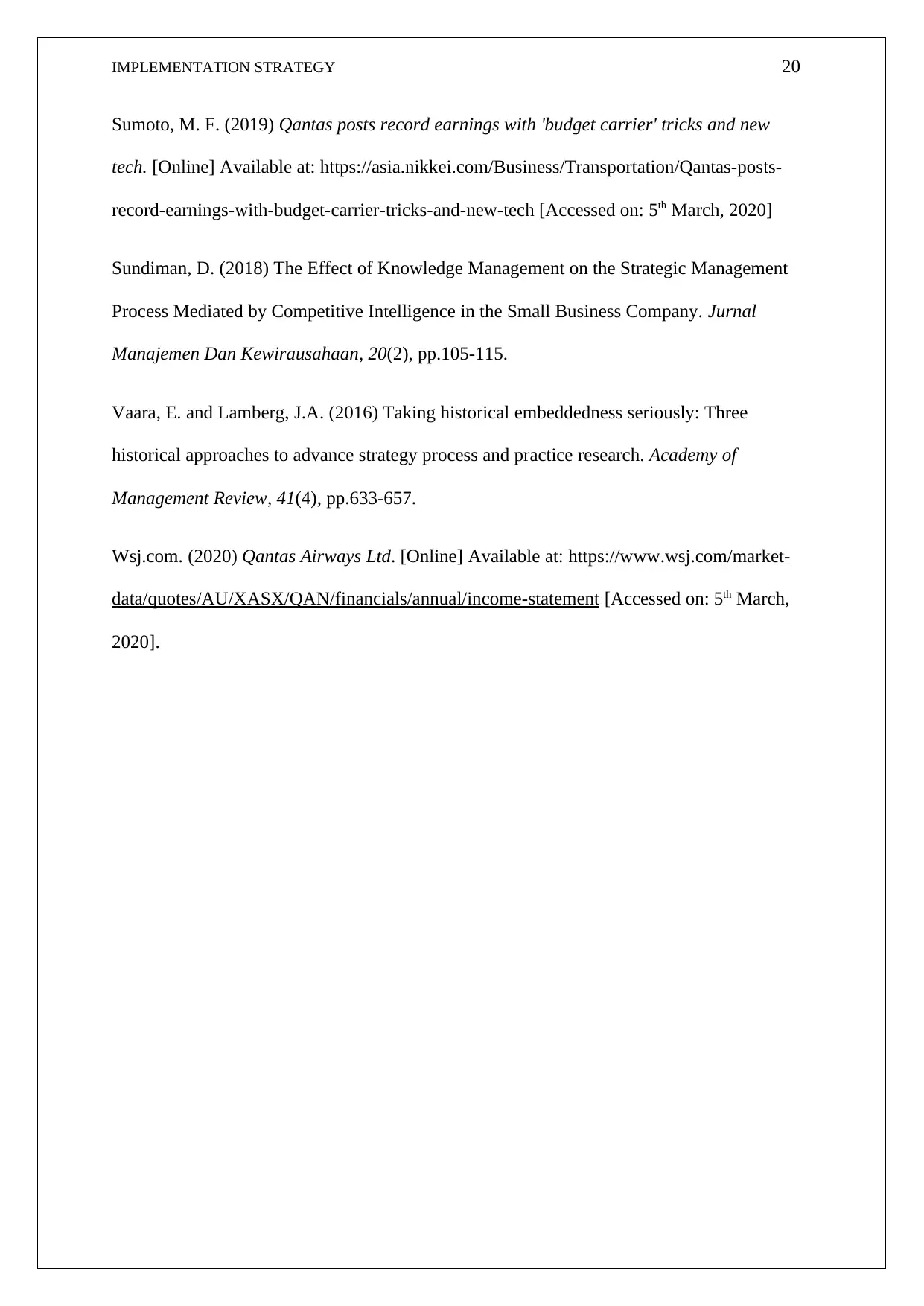
IMPLEMENTATION STRATEGY 20
Sumoto, M. F. (2019) Qantas posts record earnings with 'budget carrier' tricks and new
tech. [Online] Available at: https://asia.nikkei.com/Business/Transportation/Qantas-posts-
record-earnings-with-budget-carrier-tricks-and-new-tech [Accessed on: 5th March, 2020]
Sundiman, D. (2018) The Effect of Knowledge Management on the Strategic Management
Process Mediated by Competitive Intelligence in the Small Business Company. Jurnal
Manajemen Dan Kewirausahaan, 20(2), pp.105-115.
Vaara, E. and Lamberg, J.A. (2016) Taking historical embeddedness seriously: Three
historical approaches to advance strategy process and practice research. Academy of
Management Review, 41(4), pp.633-657.
Wsj.com. (2020) Qantas Airways Ltd. [Online] Available at: https://www.wsj.com/market-
data/quotes/AU/XASX/QAN/financials/annual/income-statement [Accessed on: 5th March,
2020].
Sumoto, M. F. (2019) Qantas posts record earnings with 'budget carrier' tricks and new
tech. [Online] Available at: https://asia.nikkei.com/Business/Transportation/Qantas-posts-
record-earnings-with-budget-carrier-tricks-and-new-tech [Accessed on: 5th March, 2020]
Sundiman, D. (2018) The Effect of Knowledge Management on the Strategic Management
Process Mediated by Competitive Intelligence in the Small Business Company. Jurnal
Manajemen Dan Kewirausahaan, 20(2), pp.105-115.
Vaara, E. and Lamberg, J.A. (2016) Taking historical embeddedness seriously: Three
historical approaches to advance strategy process and practice research. Academy of
Management Review, 41(4), pp.633-657.
Wsj.com. (2020) Qantas Airways Ltd. [Online] Available at: https://www.wsj.com/market-
data/quotes/AU/XASX/QAN/financials/annual/income-statement [Accessed on: 5th March,
2020].
1 out of 21
Related Documents
Your All-in-One AI-Powered Toolkit for Academic Success.
+13062052269
info@desklib.com
Available 24*7 on WhatsApp / Email
![[object Object]](/_next/static/media/star-bottom.7253800d.svg)
Unlock your academic potential
© 2024 | Zucol Services PVT LTD | All rights reserved.




